Exalted: Third Edition by Monathin
Introduction
Original SA post
Ah, Exalted. Love it or hate it, most everyone in the hobby has heard of it, including this thread. Polarizing, fetishizing, absolutely fucking disgusting in the case of the oft-intentionally-forgotten-about Infernals book, it’s universally agreed on by lovers and haters of the system alike that the system it works on is abso-fucking-lutely busted in all the worst ways. Combat is a slog, social influence is basically trying to brainwash each other, and all in all, everyone agreed that it was just a fucking mess. It’s a game that, honestly, if it had better mechanics, a more tightly controlled setting, and some setting bits that didn't make you want to barf into a paper bag, it'd be a much better game.
Enter Onyx Path. In May of 2013, a Kickstarter went up to help them revitalize the gameline and start anew. Nearly 700k was raised for the 3rd Edition, which, in my opinion, is pretty damn good for a tabletop book! Three years later I join this thread, holding on my hard drive the PoD version of the PDF that you can buy as of today. I’ve been playing with a group of friends since we got access to the backer first-run PDF, and while we’re not masters of this system by any means, I’ve found it fast-paced, energetic, and downright fun. It’s a version that, instead of trying to deny its heritage with anime, manga, and wuxia films of excessive over-the-top action, embraces it wholeheartedly. It’s an edition that tries to shake off its sordid past (for the most part, there are still -some- parts that make you shake your head) and give you a mechanically sound, over-the-top game in a dangerous, ancient realm.
Does it succeed? I think so, personally. Some people might disagree! But the only way to get the answer is by digging deep into this game’s guts (And there’s a lot of them, Exalted 3e is a mechanically intensive game, though it never -feels- like it in practice.) and hold them out under the microscope. To that end, I’m dedicated to trying to examine every inch of this book, front to back. It might take a year. It might take two. But I want to dig deep into the system and show off the things I like about it, and hopefully you come away liking it too. If not? Then at least we can have a civil discussion about what it gets right and wrong.
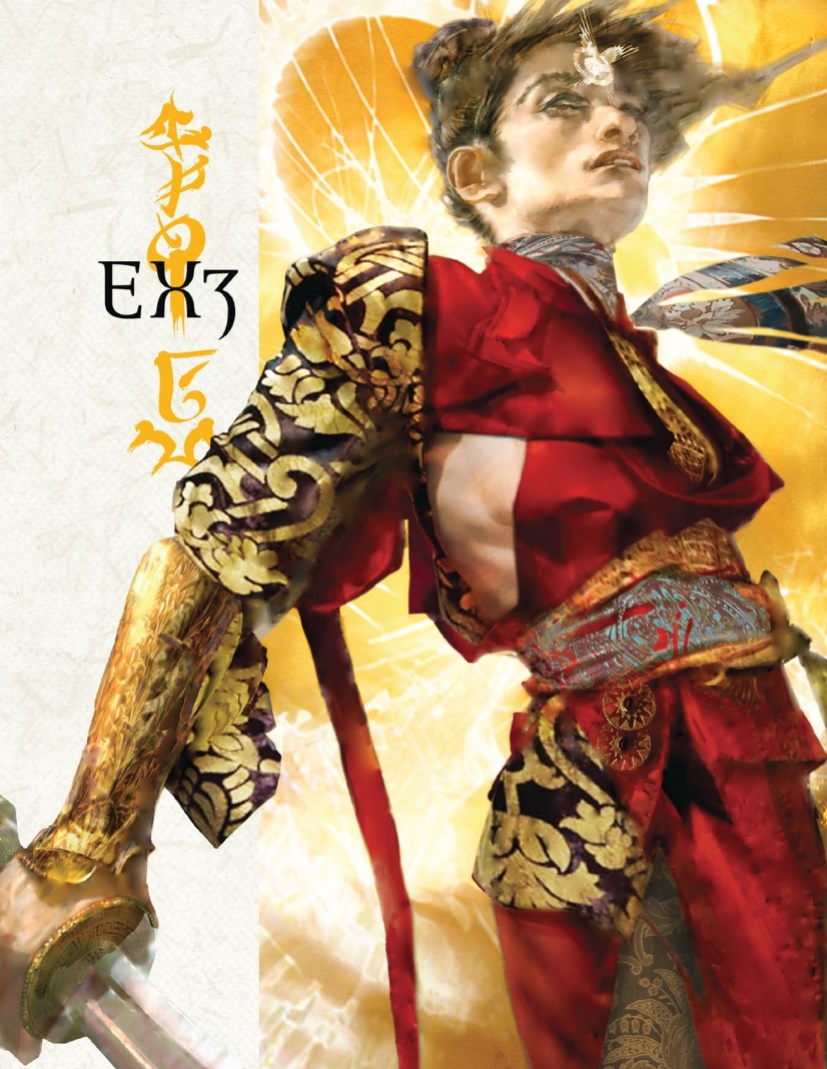
Ladies and Gentlemen, Let’s Review Exalted: Third Edition .
Part The Zeroth: Introduction
White Wolf, White Wolf never changes. Before we're thrown into the system - before we even hit the table of contents, we're treated to ten pages story set in the city of Wu Jian that's meant to hype us up for the rest of the book. I'm going to skip this, largely because it doesn't cover anything we aren't already going to cover in this introductory update, partially because I’ve never liked White Wolf/Onyx Path’s method of putting a story before you even get to the mechanics. Every time I read a story like that, I feel like the book is trying to sell me on its system when I already have the book in my hands, and that frustrates me. I think the only one I've ever read through all the way and enjoyed was the lead-in to Midnight Roads. So I’ll make note when there’s a bunch of fiction, though thankfully the beginning is the largest chunk of it.
Then, we get to the Table of Contents. And while it’s not anything that would be immediately obvious to someone that hadn’t dealt with the unindexed/first run PDF, the Table of Contents is wondrously thorough. Compare this:
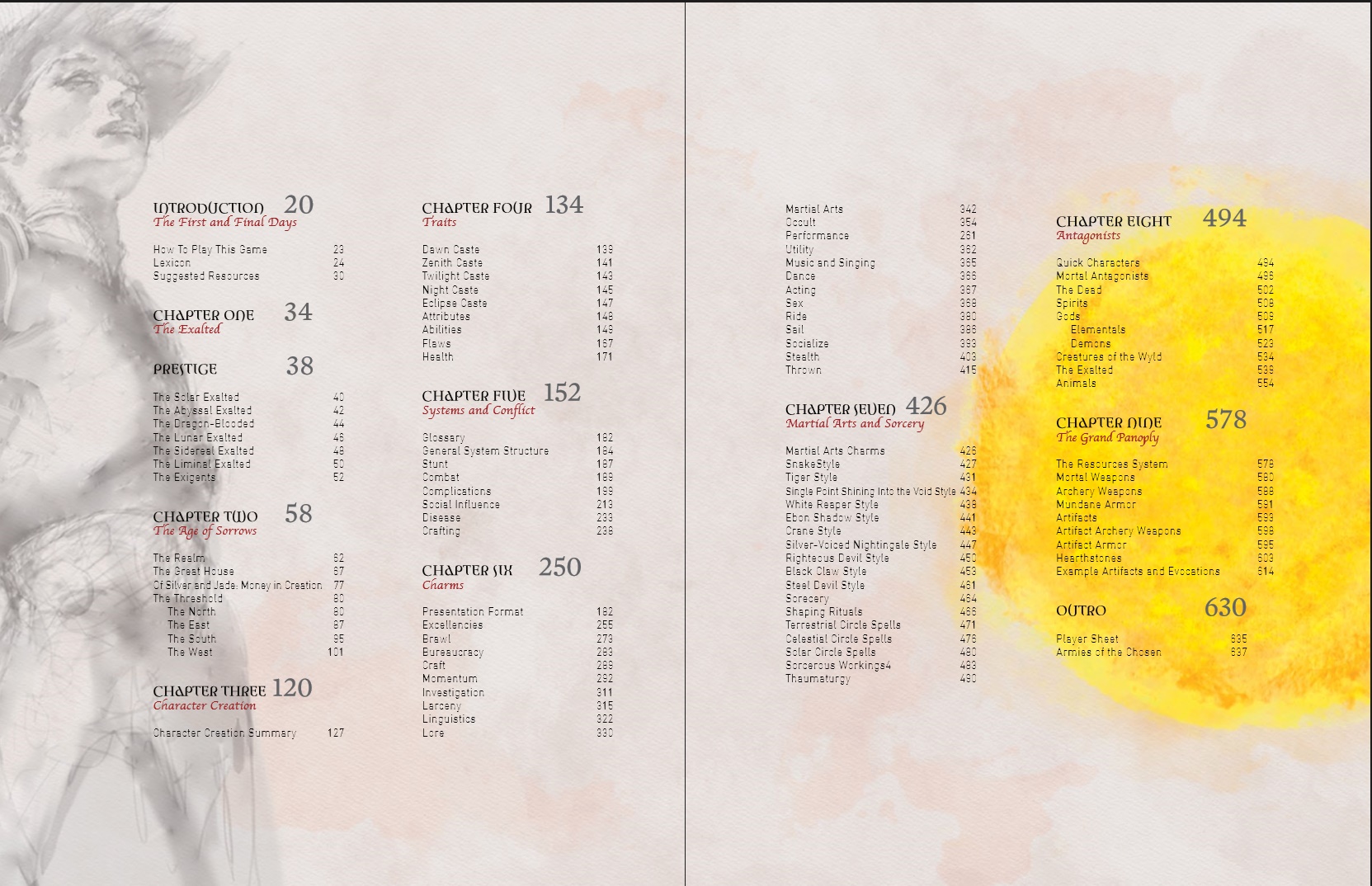
Blech.
To this:
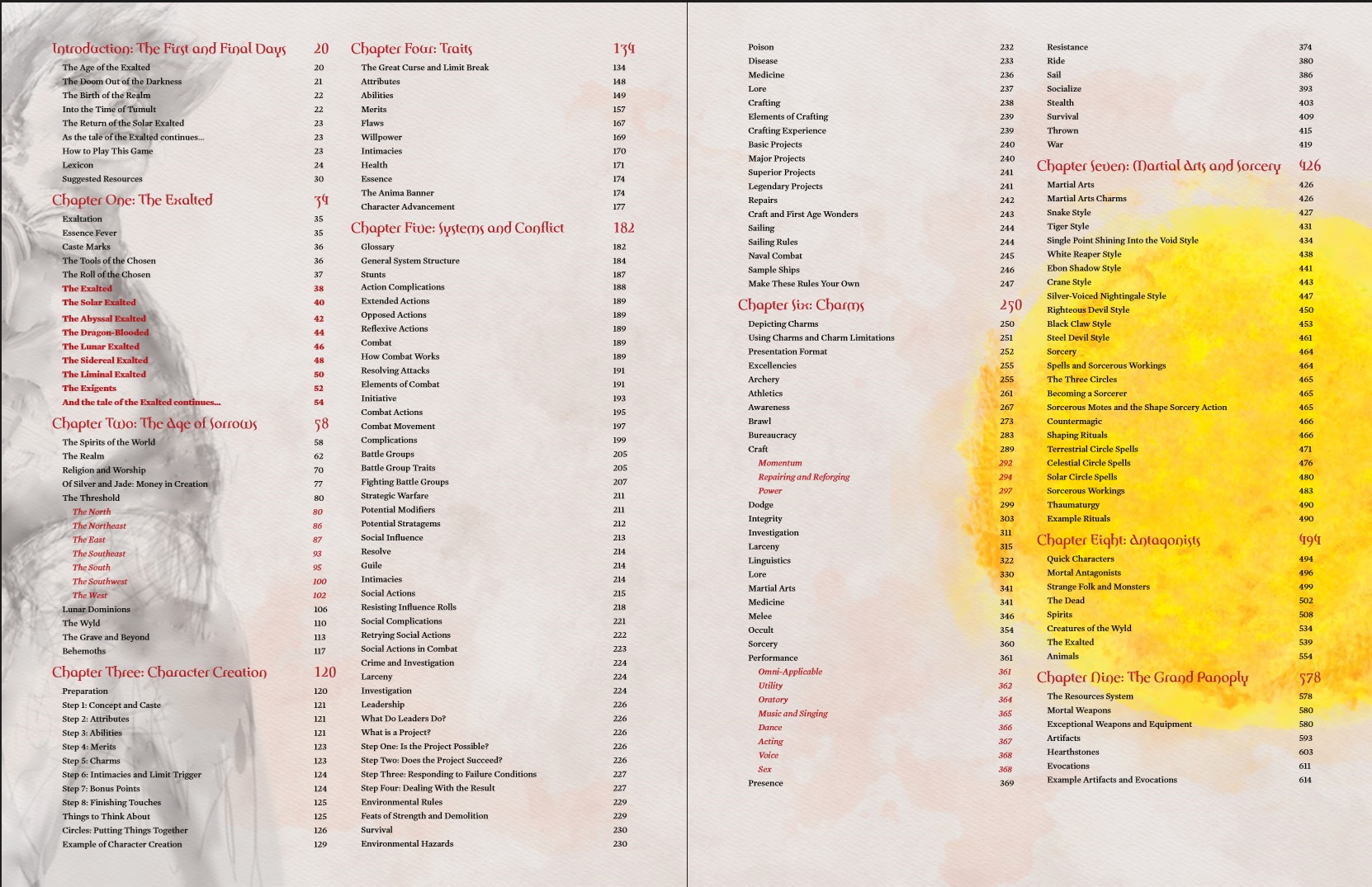
Much better, I can actually find things now!
Some complaints and arguments can be said for the organization, as it can be in almost all Exalted books - some people like Character Creation right at the front, one of the first things you get to, some people like the fact that the setting comes first, given Exalted is a setting-heavy game. Personally, myself, I would have probably at least put a section on the core mechanics in front of Character Creation so you know what some of these systems and phrases mean before you put your character together, instead of having to go through 60 more pages to find them. There’s also still a few omissions - exact details on the Solars the book is meant to help you create are spread out between Chapter One (a brief overview), Chapter Three (mechanics-wise) and Chapter Four (In-detail summaries in that gap between 134 and 148, special Anima Banner effects under 174). It’s not god-awful, but it’s a damn sight better than the first-run PDF. I’m going to be compiling from some of the other chapters as-needed, noting where it’s particularly egregious (like the first example), because I want this guide/review to be as comprehensive as possible.
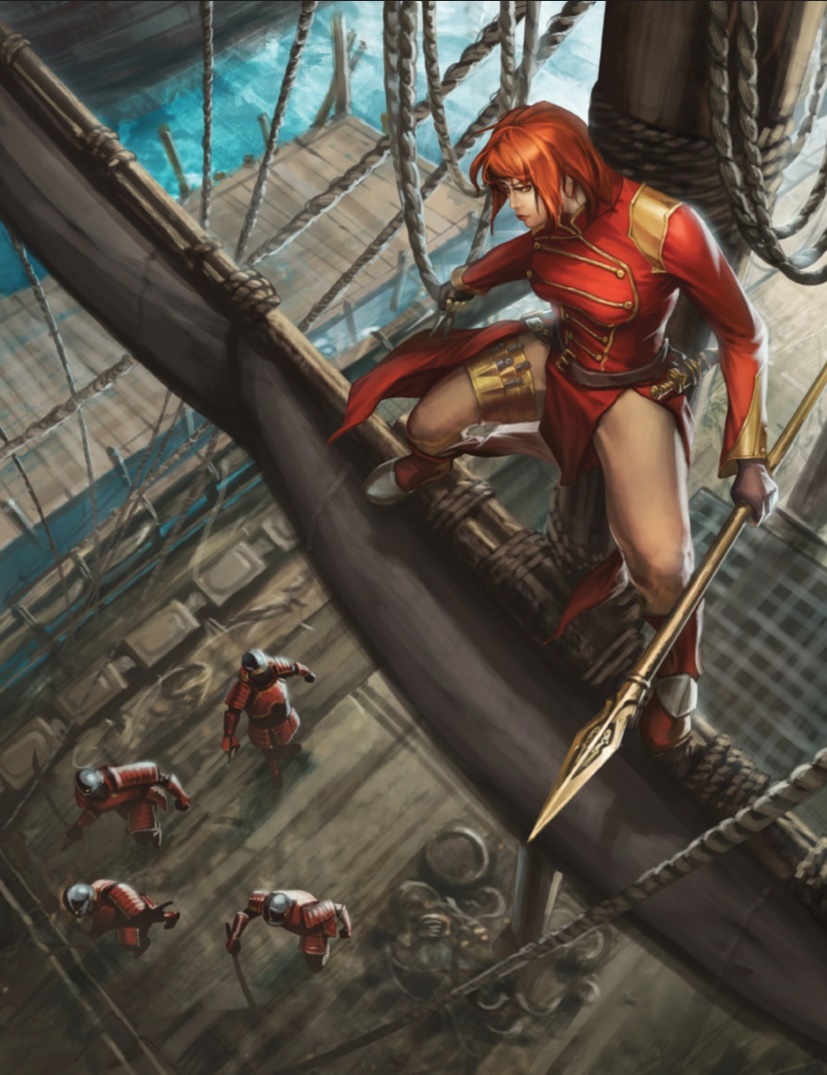
This book’s art is pretty damn good, for the most part.
After the table of contents, we’re treated to the usual legal acknowledgements, a short one-page story (much more digestible! More of these!), and then we dive right into the setup. It’s been summarized before, but for the thread, I’ll give an overview: In the beginning, there was chaos, the world of Creation shaped from it. The Primordials (though they aren’t specifically outlined, they’re clearly there) ruled over the world and the Gods of that world. Unable to turn on the Primordials that chained them, the Gods created from Mortals the Exalted, champions and paragons of these gods, unbound by the Gods’ restrictions, they rallied against the Prometheans and cast them down, freeing the Gods and ushering in the First Age - an age of glory and wonder lead and championed by the Solar Exalted - the most talented Exalted, brought forth by the strongest of Gods, the Unconquered Sun. For five thousand years, the Solars ruled Creation, working hard as the rulers of the domain.
Of course, the Primordials are the ones who get the last laugh, cursing the Exalted with their last breath to deal with madness, wickedness, and spite. They grew greedy, sinful, and turned on each other in a civil war for power, followers, and respect. Mad with power and unwilling to listen to reason, the Dragon-Blooded Terrestrial Exalted, with the aid of the fate-weaving Sidereals, overthrew the Solars and their partners - the Lunar Exalted. So began the Usurpation. Most all the Solars were slaughtered to the last, their souls trapped in a prison of jade - as the Lunars fled for parts unknown. In the wake of this, much of the First Age came to ruin - Creation buckled under its own weight, kept stitched together just barely by the Dragon-blooded - who set up their own Shogunate, and the Sidereals - who established the Immaculate Philosophy to justify the hunting of the Solars, and the Wyld Hunt to carry out finding the remaining escaped Solar and Lunar Exalted. Having done this, they erased themselves from history, manipulating the stars and the fates so that most everyone would forget that they existed.
Reality wasn’t done fucking with Creation yet, as this Second Age begins with the Great Conntagion - a plague that kills 9/10ths of the population, setting the stage for the invasion from outside its borders - the Wyld. The primal chaos which Creation was shaped from, and the Fair Folk - those who reside in the Wyld, who desire nothing but the destruction of the order of Creation, who can only subsist in its ordered realm by feasting on the hopes, dreams, and souls of mortals. Planning to split creation at the seams from the very center of it, a lone Dragon-Blooded was able to brave the ancient, near-impenetrable defenses of one of the Solars’ last working and largest artifacts from the First Age - the Realm Defense Grid. Managing to bring it online at the eleventh hour, she sent the Fair Folk scrambling back to the borders of Creation, and saved it from utter annihilation. The Shogunate dead and in control of the most powerful weapon in Creation, she did what any reasonable authority figure would do - she wrested what was left from anyone who would oppose her, forced the ones who didn’t to swear fealty to her, and ruled from the center of Creation as the Scarlet Empress.
The Dragon-Blooded’s Shogunate was reborn as the Realm, organized into houses that the Scarlet Empress pitted against to keep them busy enough to keep them from overthrowing her, and set out establishing her rule in all of creation - with the exception of the East, who were protected mostly by the fact that they’re waaaaay the fuck over there and they needed, y’know, boats and shit to get over there.The Sidereals come back into the picture here, aiding the Scarlet Empress in exchange for the establishment of the Immaculate Philosophy and the continued establishment of the Wyld Hunt. This went on for nearly eight hundred years.
Then, she vanished. And of course, with no central figurehead, the Realm began to deteriorate, the houses that had bickered over meaningless power grabs now bickered over the most meaningful power, as the Empress planned no order of succession. A figurehead was placed on the throne, and the Realm recalled its forces abroad to deal with the manipulations and political skullduggery needed to fight itself for supremacy, causing the downtrodden subjects of the Dynasty to rebel, the Lunars - those who had remained, fighting on the edges of creation - stepped up their retaliations against the Dragon-Bloodeed for past crimes, the Fair Folk rumble beyond Creation, eager for a rematch without the Realm Defense Grid to provide an ultimate trump card; and the city-state of Thorns - once one of the largest tribunes of the Realm, was slaughtered to a man by the forces of the Deathlord known only as Mask of Winters, riding atop his throne, the Corpse-Fortress Juggernaut, casting fear over the Scavenger Lands, which quickly lapsed into individual fiefdoms, city-states, and settlements outside the Realm’s rule.
It is into this time, the Age of Sorrows, the Solars are finally reborn - the jade prison holding their souls has broken open, allowing them to reincarnate and Exalt anew. The Wyld Hunt has lapsed, the Realm’s borders no longer stable or expansive enough to patrol all of Creation. The book posits only one question: Will the Solars save the world? Or doom it to destruction?
From there, it dives into a how-to-play, which gives a sort of standard boilerplate ‘what is a roleplaying game’ overview, and then a lexicon of need-to-know terms I’m not going to summarize here because I’ll be covering near all of them when we get to them. It also gives us a summary of various media that went into the influence of Exalted, especially Third Edition. The usual suspects are there (Conan, Journey To The West, Night’s Master, The Bride With White Hair), but it also comes forth and admits quite a bit of anime, manga, and videogame heritage. From Inuyasha to Claymore to Ninja Scroll to Dynasty Warriors. There is one particularly important influence that doesn’t get a lot of expounding on-
Exalted Third Edition posted:
Dissidia Final Fantasy, Square-Enix
Dissidia’s heroes wield giant weapons and over-the-top magic that fits right in with Exalted. Its agile, cinematic battle system was the single largest influence on Third Edition’s combat rules.
Remember this for later, it’s quite important.
Next time! Part the First: So what IS an Exalted?
What IS an Exalted? (Alternative Title: Solars and Friends)
Original SA post
I’m not gonna lie to you all, I’m trying to get through a lot of the fluff (or at least the stuff that near everyone would know) as quickly but thoroughly as possible so I can get to the stuff I actually want to cover (combat mechanics, charms). This part is going to be a bit composite, since it’s taking the majority of Chapter 1 (which is ostensibly an overview of Exalted and previews for later books in the line, as is typical WW/OPP Tradition) and merging it with some of the details from Chapter 4 and Chapter 3.
Part The First: What IS an Exalted? (Alternative Title: Solars and Friends)
Exalted are specifically called out in-book as larger-than-life heroes. Mortals given divine power. The world’s answer to turmoil where simple mortals are simply not up to the task. Passing sickness becomes a thing the “Chosen”, as they’re called, can simply ignore, and the book points out that Exalted can live decades, even centuries longer than the average human, citing about 300 years for Dragon-Blooded, 3000 years for Solars and Lunars, and about 5000 years max for the Sidereals, with other types varying wildly. This is, of course, subject to a lot of variance due to the fact that most Exalted subscribe to the “live fast, die young, leave a beautiful corpse” lifestyle.
The thing that makes that makes Exalted such a big deal is that they can tap into Essence, the life-force of the world, and shape it to their will to perform miracles. Most of these miracles are Charms - innate talents that must be discovered or learned by Exalted. (There’s training time rules, but we’ll get to them when we get to them.) It then goes into detail about the act of Exaltation itself, noting that Exaltation is almost always in a moment of great turmoil, before feeling the energy of the world rushing into them, and feeling the power that Essence can grant you for the first time - Mortals have Essence, naturally, but cannot tap into it like Exalted can. It’s worth noting that Solar Exalted do not get an explanation as to what has happened to them, with the exception of Zeniths - who get a mandate from ol’ Unconquered Sun himself to go out and make the world righteous to the best of their knowledge and ability. Usually, the Exaltation will happen in a way that confirms that Exalt’s particular Caste. It’s not uncommon for a Dawn to Exalt mid-combat, or a Eclipse to exalt while putting all their diplomatic cards on the table.
There’s a few more notes, primarily about how Essence feels and how using it is an adrenaline rush, called “Essence Fever”. There’s nothing mechanical to this, just simply equating the first adventures a new exalt is likely to have are comparable to a supernatural adolescence - Essence always subtly urging the Exalt to Do More, Go Bigger, Go Further Beyond. With time (read: Experience), Exalts get better at tempering this feeling, but it never goes away, they are heroes, after all.
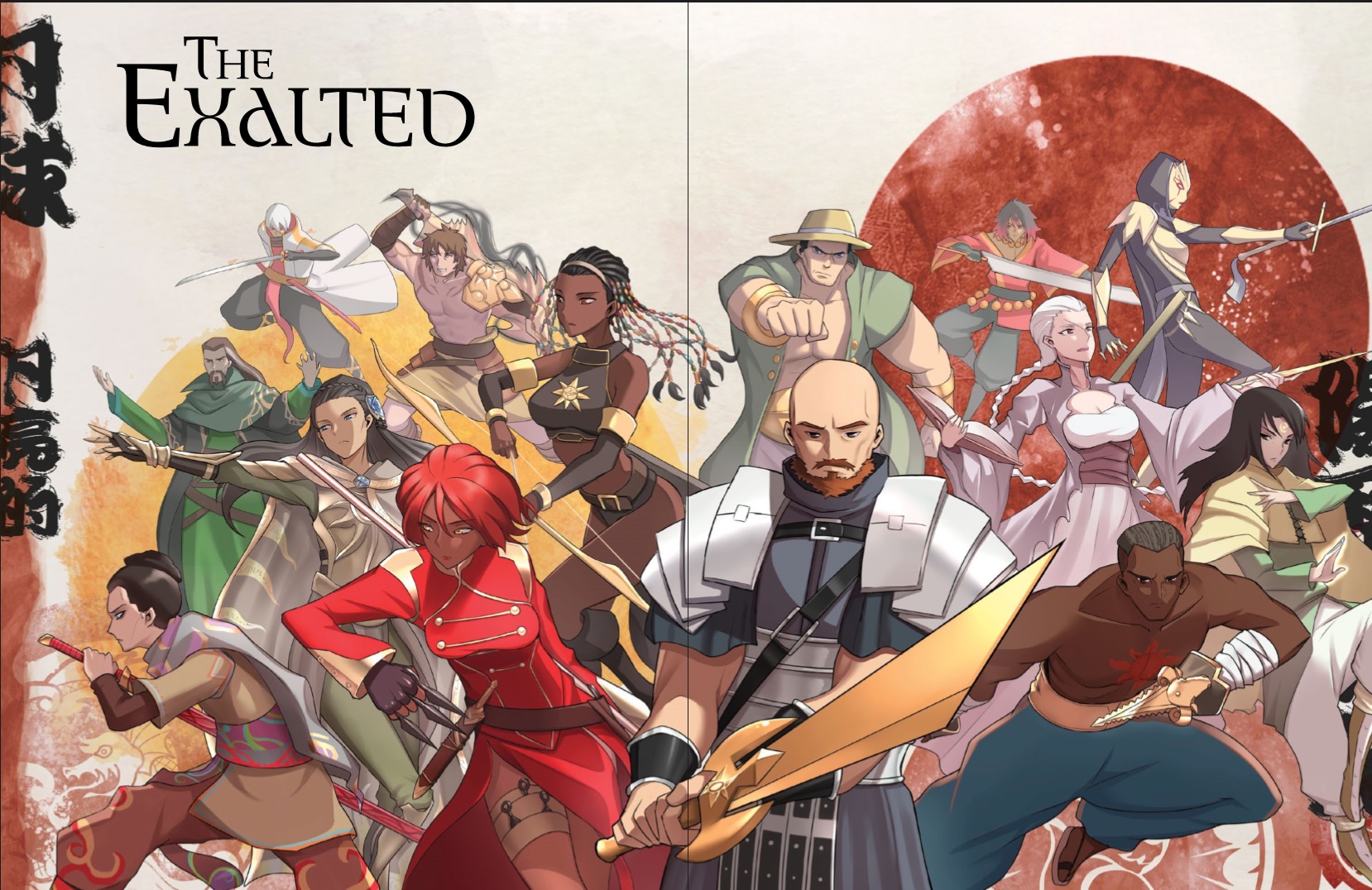
A pretty swanky - if decidedly more Animesque two-page spread brings us to our next section.
After that, the book moves on to summaries of all the Exalted, which end up closing out the chapter. I’ll go into the others later, but for now, let’s focus on the meat of this update, A.K.A “I pull from wildly disparate parts of the book to introduce you to what this book wants you to make: a Solar Exalted.”
Exalted Third Edition posted:
Forged from the power of the greatest of gods, the Solar Exalted are the spiritual mimesis of the sun and all it represents: glory, magnanimity, power, relentlessness, inspiration, creativity and ascension. As the sun dominates heaven, so too do the Solars shine brighter than their peers. They are natural-born leaders, scholars, warriors, and builders, brought forth from the greatest heroes of mankind and set on high as the Unconquered Sun’s own champions. The Solar Exalted are the greatest of all the Chosen. Be they benevolent or tyrannical in their courses, the Solars’ natural mastery of the world and their ability to uphold the loftiest principles has earned them the sobriquet of the Lawgivers.
These guys are the top of the food chain. They get the strongest sorceries, they have the most raw talent for a skill, and nothing is gated off to them. They’re the most powerful of the Exalted in terms of sheer amount of what they can do, and Solars get some of the strongest Charms, full stop. A Solar is back to being a Big Fucking Deal, not the least because the Wyld Hunt has been making sure Solars haven’t been around for a good few thousand years.
The Solars are divided into five castes, each of them promoting a different archetype of play you can mess around with, a plethora of anima effects (at least one which will see constant use, a ‘signature character’ to represent that, Caste Abilities (which, aside from three you pick out yourself as ‘Favored’ abilities, are your Caste’s signature skills) and what the Immaculate Philosophy thinks of them/calls them.
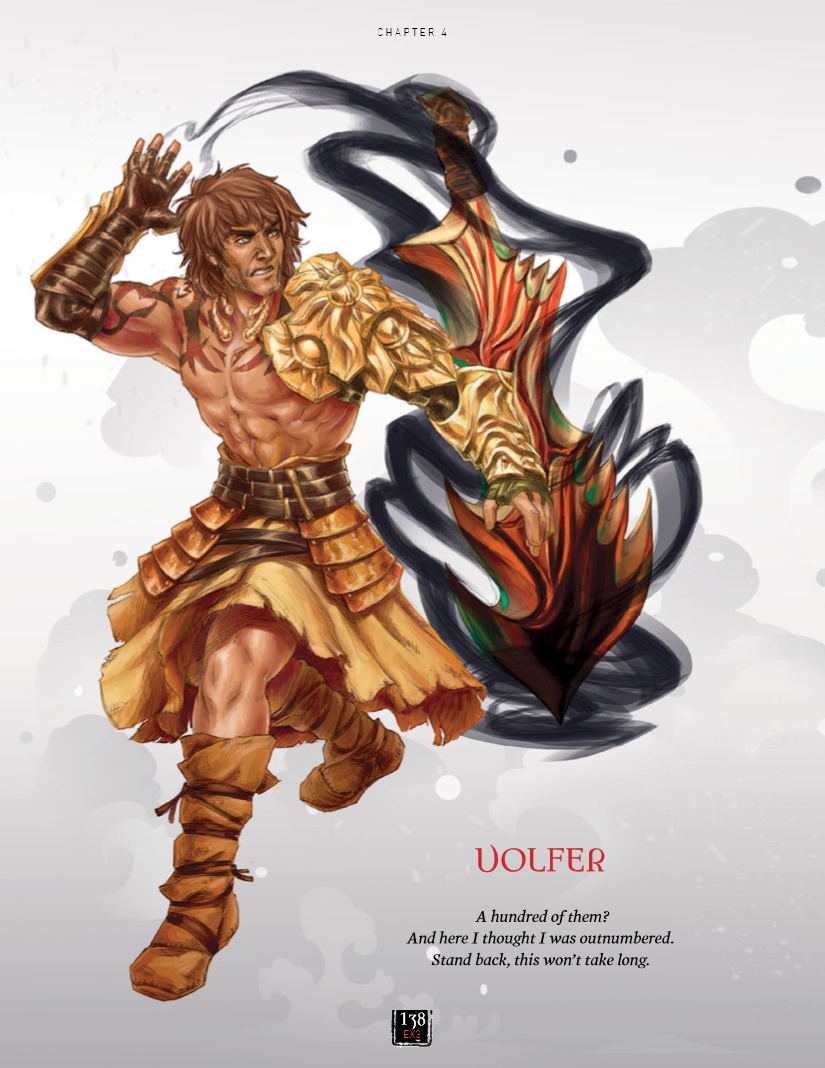
Dawn Caste are your generals and warriors; known as the Spears of Morning, the Swords of Heaven, the Lightbringers, and a handful of other such names, they are your go-to if you want to be a champion in the old-school martial sense, or the guy who sees a giant fuckoff dude and go “I want to fight that.” In editions past, the Dawns were kind of sidelined as the masters of arms, but 3e revisits that and gives them proper treatment: The Dawns have access to every combat ability (Melee, Brawl/Martial Arts, Archery, Thrown) as a Caste ability (what this means we’ll get to later, but rest assured it’s Good Shit), as well as Awareness (which is linked to your Join Battle AKA Initiative Rolls), Dodge and Resistance (two of the main defensive stats), and War (for if you just wanna chuck an army at someone instead of doing the fighting yourself. The Immaculate Philosophy labels Dawns as the Forsaken, brutish, cruel dullards summarily abandoned by the others during the Usurpation.
Dawns get access to a few really key abilities through their ‘Anima Effects’, effects that Castes can just -do- at any time, no charm required. The most often used is the passive, which lets you add half your Essence to your Initiative when you spend it all to land an attack, allowing them to get back in the fight sooner. They’re also able to reset all their combat charms with outstanding cooldowns once per day, and are also scary motherfuckers - so intimidating that they add their essence to intimidation, and can intimidate things that don’t feel fear, such as undead and constructs like golems.
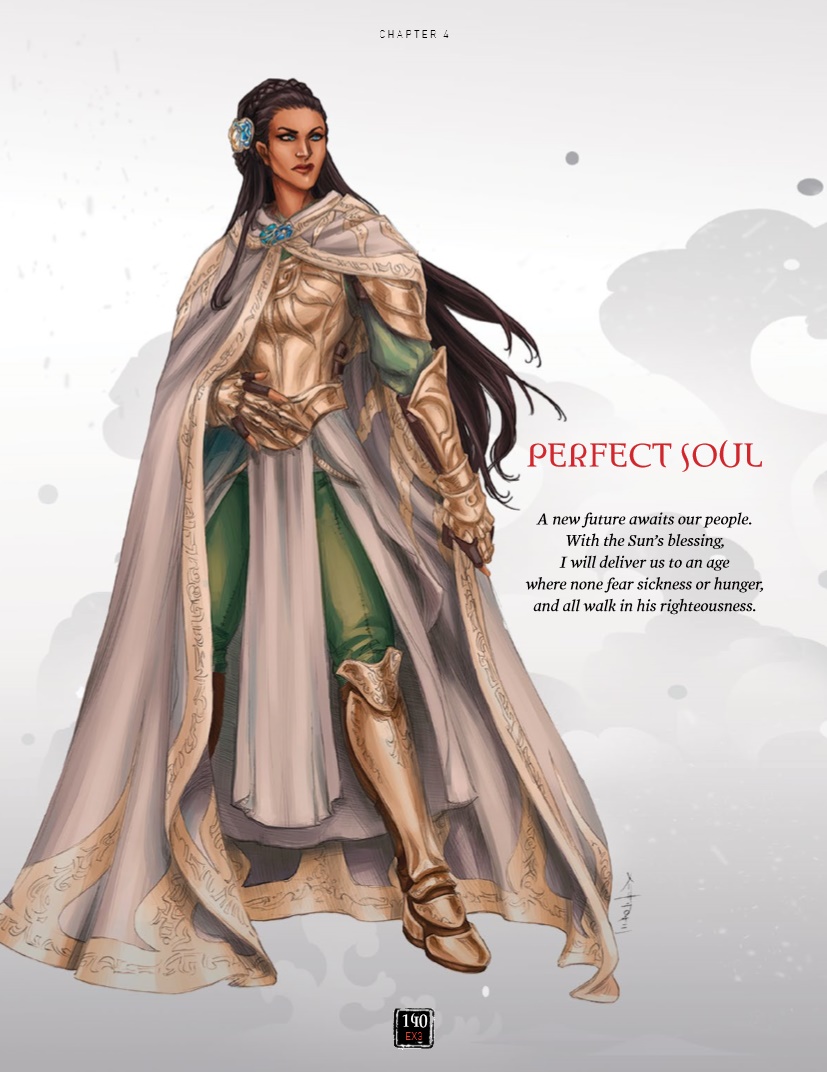
If Dawns are the warriors, champions, and generals of the Unconquered Sun, then Zeniths are the warrior-priests and commanders. Arbiters of authority, the Zenith is the champion of righteousness, and in both setting (due to being the only one Unconquered Sun speaks to directly) and in skills to be the Leaders of your group. They’re the only other Caste, other than Dawn, to get War and Resistance as Caste Abilities, making them uniquely predisposed to being tanky as all-hell while commanding a tactical battlegroup in a way that works far better than Dungeons and Dragon’s Leadership rules ever did. They also have Athletics, Integrity, Performance, Presence, Lore, and Survival, meaning they can provide for others, as well as be an in-a-pinch diplomat who excels more at stirring hearts and minds than intense negotiations. Immaculate Doctrine calls them The Blasphemous, hedonist priests who enslaved the innocent and indulged in every kind of morally wrong behavior imaginable.
Zeniths get access to a few really cool abilities. The most readily apparent is that Zeniths, furthering their Paladin-esque identity, get access to a Smite Evil, allowing you to make an attack against a creature of darkness without spending the Initiative required. Usable once per day. They can also administer funeral rites to the damned, accepting their values as his own, or even turning the pain against their killer with a simple touch. They can also order spirits to materialize in the material world.
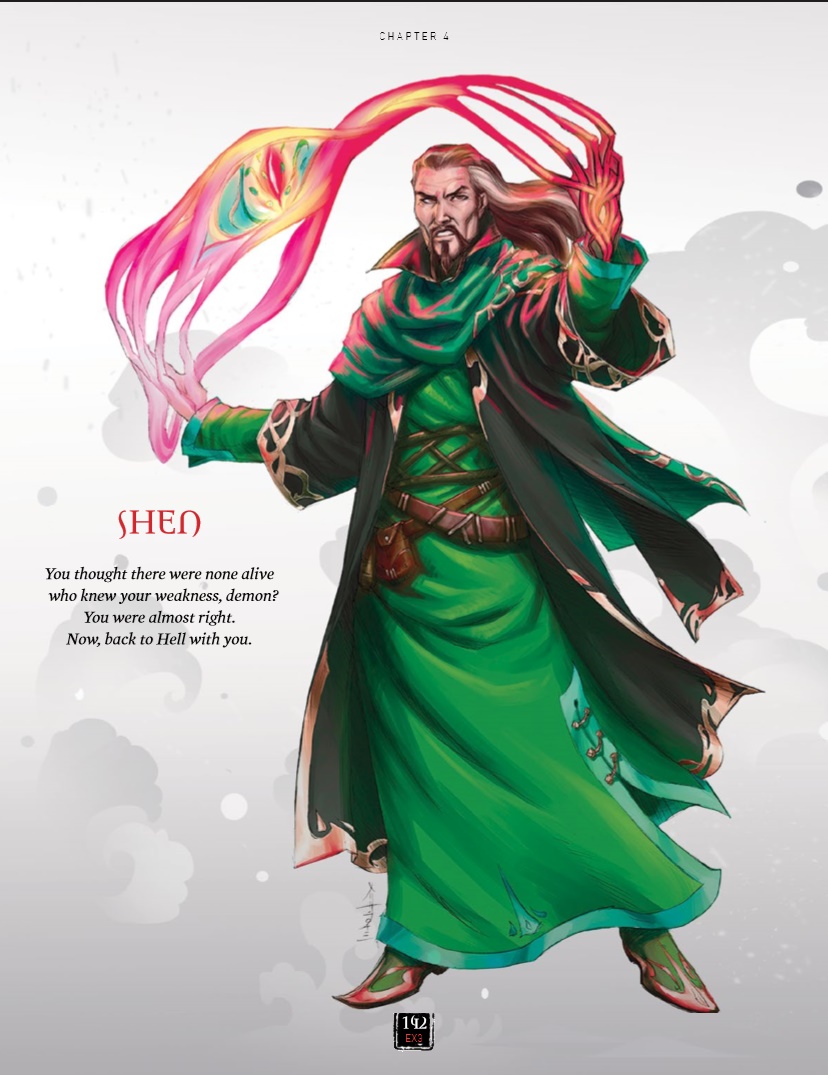
In contrast to the tanky leader of the Zenith or the brute-force combat of the Dawn, the Twilights are your brainy Solars. They’re the masters of scholarly records, lore, crafting, research, law, investigations, and learning. Most of all, they are occultists - of the five Castes, they are one of the two that most commonly dives into the Occult for their methods, making them near undisputed masters of Sorcery (though some Eclipses would like to disagree). Often marked by undying curiosity, if the Zenith is the front man and the Dawn’s the bruiser, the Twilight is undoubtedly the brains (and occasionally the medic) of a well-oiled Solar Circle, researching and ritualizing the solution to problems that can’t be solved with words or simple human deeds. They gain access to Bureaucracy, Craft, Integrity, Investigation, Linguistics, Lore, Medicine, and Occult abilities. To the Immaculates, they are The Unclean, power-hungry, demon-bargaining Cthulhu Mythos style mad cultists who would sacrifice an entire city to further their dark knowledge.
Twilights, due to their sorcerous nature, are often squishy by Exalted standards, they don’t really get much chance to devote themselves to Resistance Charms, and can often be first-focused in a fight. To this end they have a few tricks to keep them They can harden themselves to take less damage from a decisive blow, as well as bind and reflexively summon demonic familiars to serve as bodyguards. If all else fails, the Twilight has a near-guaranteed ‘get the fuck out’ card by being able to vanish for until the next sunset, reappearing at a place of power nearby.
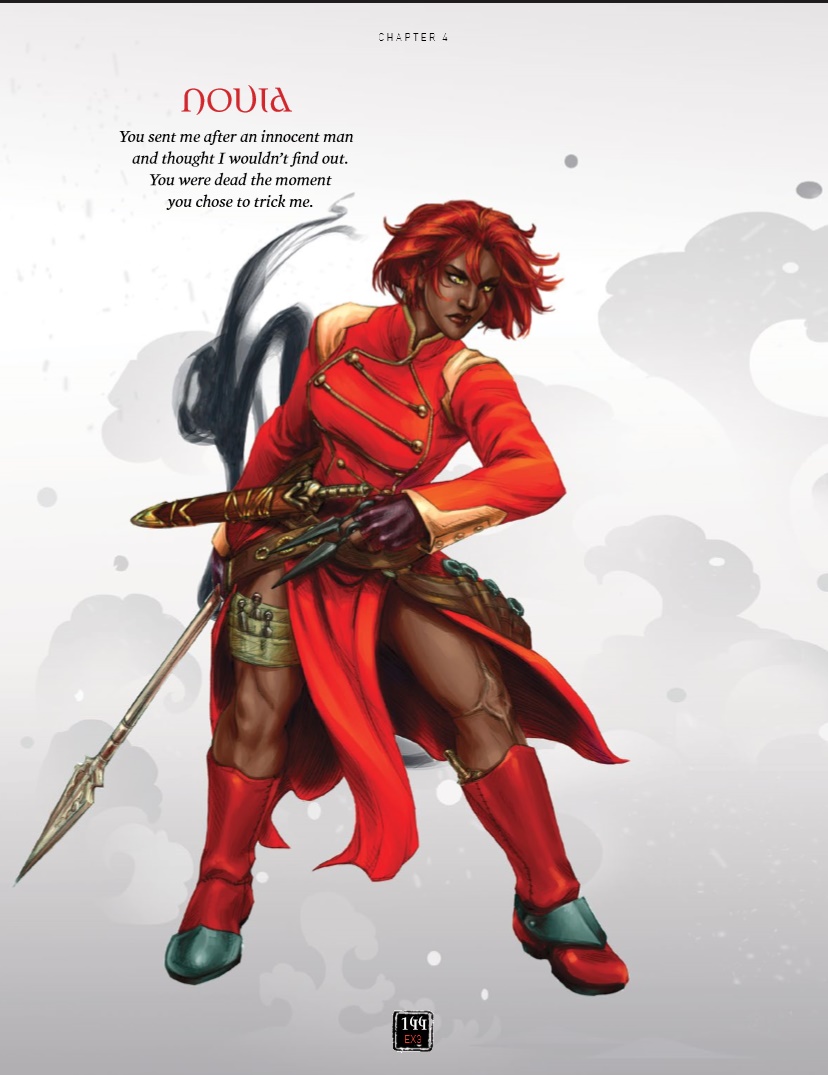
We’ve had our “typical” Fighter, Paladin/Cleric, and Wizard/Sorcerer. What’s next? Rogues, of course. Night Castes are the experts and naturals when you need to do something more nuanced and subtle, rather than crash the gate open or get a demon to do it. The original Night’s Watch of Creation, they are spymasters, ninjas, assassins, the subtle master of surroundings and sabotage, the Night Caste is meant to evoke all these. Of all the Solars, only the Night Caste gets access to Stealth as a Caste ability, meaning they’re the most logical choice for someone who wants to infiltrate, or make sure they aren’t seen until they -want- to be seen. The combination of Athletics and Awareness means that not only is nothing out of the Night’s sight, but neither are they out of reach. They get Dodge to help them nimbly avoid attacks, Investigation to snoop around, Larceny for good-old B&E, Ride for the occasional speedy getaway, and Socialize to help them manipulate on a social level instead of just on a physical one. In a pinch, they can cover a pretty broad range of Social maneuvers (with the Zenith picking up the slack for impassioned speeches). To the Immaculate, they are the Wretched - the Anathema Secret Police, dragging people away in the dead of night as they cried against tyranny, never to be seen again.
The Anima effects of the Night Caste are simple and straightforward, allowing you quite a bit of freedom to pull off stealth assassinations and other incredible feats in silence. They can dampen their anima banner to keep themselves from being noticed, can ignore penalties to Stealth, and, at their strongest Anima level, becomes an anonymous form - you exist, and people can see you, but your features are obscured to the point where anyone who saw you would not be able to tell who you were.
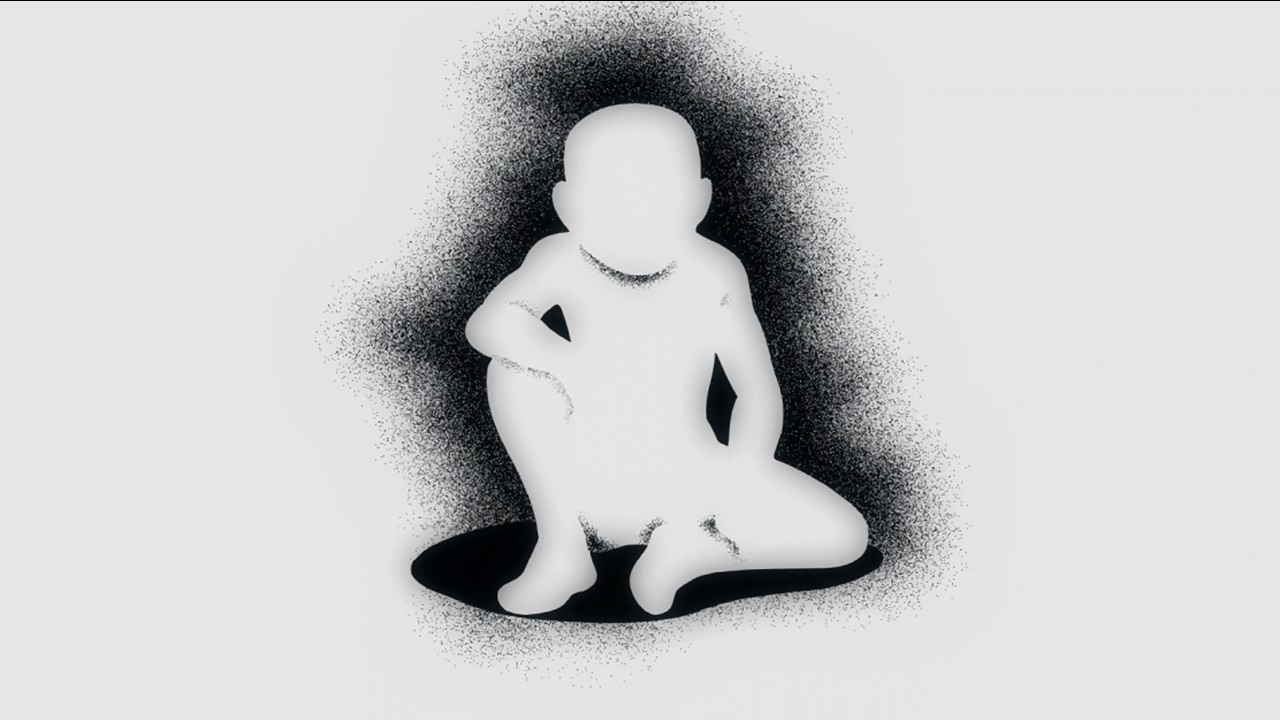
Kind of like this.
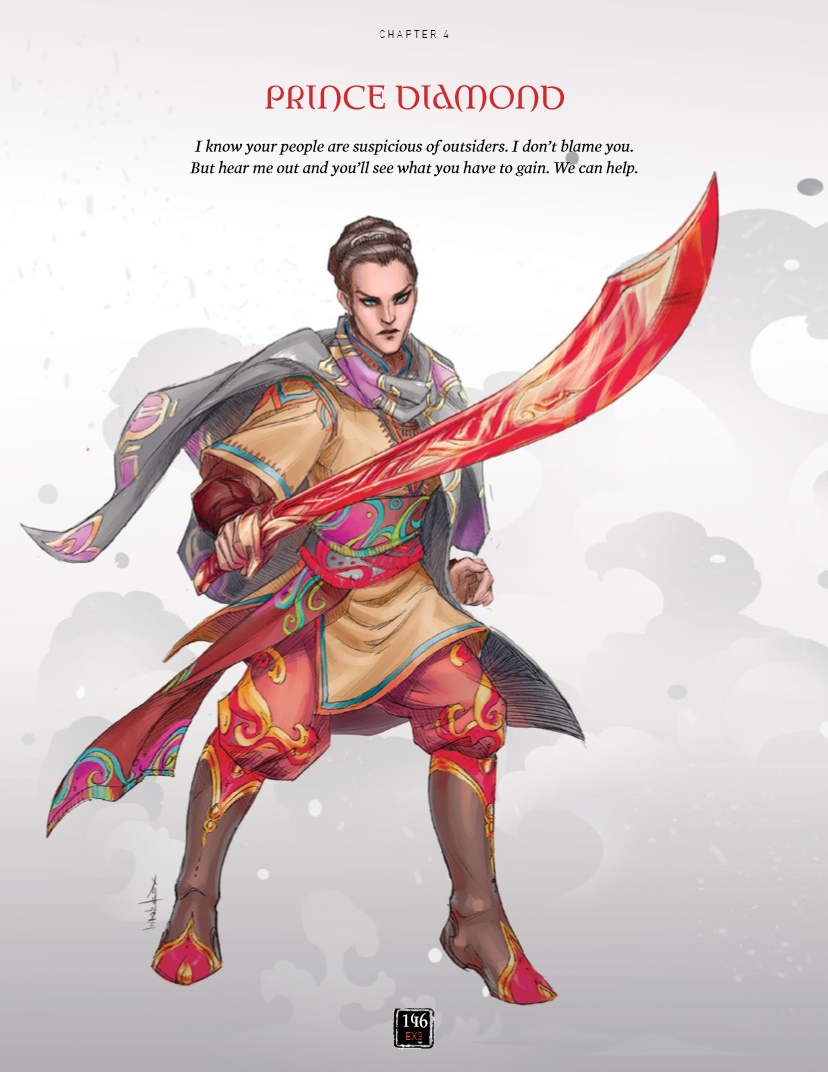
A note on this that I find pretty cool - Prince Diamond is officially a transgender character - that grey shawl he wears means that people he meets in his society have to refer to him with male pronouns, despite being female at birth and when he does come up in the book he is referred to specifically as a he. Good on you, Onyx Path.
So what of the Eclipse Caste? In the before times (read: 2nd Edition), they were given a very lowly amount of abilities, the considered ‘leftovers’ of 2nd Edition, with the caveat that they were broken due to being able to learn any charm in the game. In 3rd Edition, they’ve become the more dextrous social companion to the Zenith’s leader game, with a hint of sorcery. Flavored as travellers, explorers, ambassadors and diplomats, the closest they come to in terms of ‘classic’ fantasy classes is the Bard (Or a Blue Mage, in Final Fantasy terms). Eclipses come packed with both Presence -and- Socialize, as well as Bureaucracy, Larceny, Linguistics, Occult (giving them access to Sorcery), Ride and Sail. Personally, I’d also pick up Performance as a Favored Ability if your Zenith isn’t focusing on it, but that’s neither here nor there.
For their special effects, they’re once again given their signature skill in being able to jack the Charms of other non-Solars - most notably spirits, Fair Folk, and others of supernatural ilk. The key difference this time is that the charm has to have the ‘Eclipse’ keyword to be learned by the Eclipse Caste, which gives their power more of a Blue Magic flair and is presumably far less of a nightmare to balance around. They also have diplomatic immunity - so long as they have legitimate business, they can’t be attacked by Shades, Spirits, Fair Folk, or the demon princes of Hell without just cause, and must observe rules of hospitality. This doesn’t mean they can’t provoke you into starting a brawl and then kicking your shit in, however. And they also can curse people who break an oath that they’ve personally sanctified.
And that’s it for the Solars! There are many other Exalted, but since this is A) Only a book about how to create Solars and B) this post is long enough as it is, I’m gonna do my best to quick-summarize them.
Abyssals are the Blackguards to the Solars’ Paladins. They’re there opposite number, champions of death and of the Deathlords. Their Castes are the opposite number to their Solar counterparts, each sharing the same mark, except in blackened brands rather than golden sigils. Their Castes are Dusk (Dawn foil), Midnight (Zenith foil), Daybreak (Twilight foil), Day (Night foil), and Moonshadow (Eclipse foil).
The Dragon-Blooded are the most numerous of the Exalted, owing in part to their Exalt powers being passed by lineage instead of being found worthy and just Exalting. They correspond to the Five Elemental Dragons of the world, with their own five castes that neither match or foil their Celestial brethren. Their
Once the dynamic foil to their sun-shining counterparts, the Solars, the Lunar Exalted fight a war amongst themselves both inside their hearts and among themselves. Shapeshifters, Wyld Walkers, and wielders of primal Chaos, the return of the Solars means that factions friend and foe and unsure as to whether it means an end to the tyrannical hegemony of Dragon-blooded, or whether they’ll be once again shackled to the Solars as their living shadow. Their casts are Full Moon, Changing Moon, and No Moon.
Sidereals are the Exalted of the Fates and Stars. They can tell the future just as quickly as change it. The weakest of the Celestials, they find their power by weaving fate and inscrutable, mystical martial arts - who only the Solars could match hand to hand. They’re split not just by Caste, but by faction. The Bronze Faction believes the return of the Solars must be stamped out as quickly as it has arrived, whereas the Gold Faction believes that these new Solars, with the help of Sidereal guidance, can retake the glory of the First Age and restore the crumbling Creation to its magnificent splendor. Their Castes are the Chosen of Journeys, Serenity, Battles, Secrets, or Endings.
The Liminal Exalted are strange. While briefly mentioned in 2nd Ed, they get a full spot here. The Hunters of the dead and exorcists of spirits, they are crafted by human hands from strange magic from beyond the grave as near-literal Frankensteins. In a lot of ways, they’re Exalted’s response to Promethean: The Created. These new beings are undying, and have an undeniable tie to a human, usually their creator - for if that bond should break, they start a slow descent into the madness of undeath. Their Aspects are Blood, Breath, Flesh, Marrow, and Soil.
Exigents are the odd man out:
Exalted Third Edition posted:
Sometimes there is calamity beyond measure. Sometimes there is crisis beyond reckoning. Sometimes the world must have a champion, but does not. Then the gods themselves lift their faces to Heaven, and utter a prayer for deliverance.
If the need be sufficient, the god without any other recourse, and the heart of the Unconquered Sun moved by the prayer, he may answer and send down a portion of his divine fire. This is the Exigence: a gift of Exaltation, an extreme sacrament handed down to answer the most urgent of disasters.
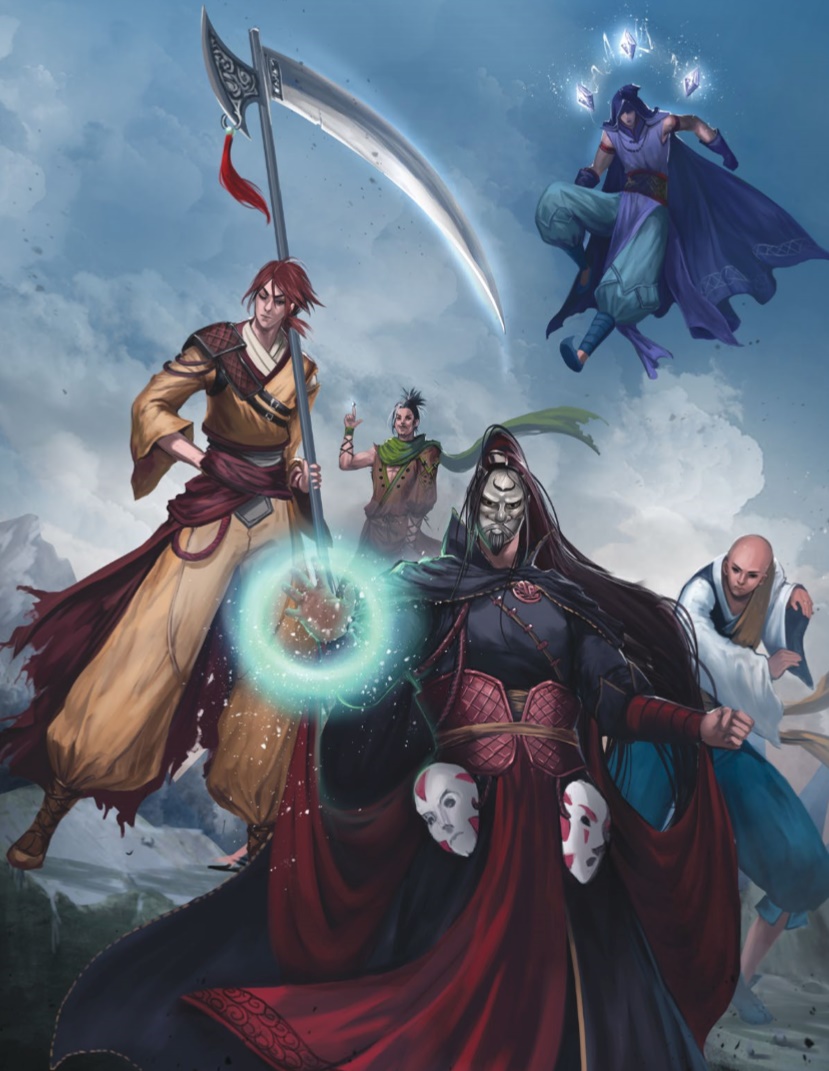
No, seriously, who the fuck are these jokers.
Nevertheless, they’re probably getting a book sometime
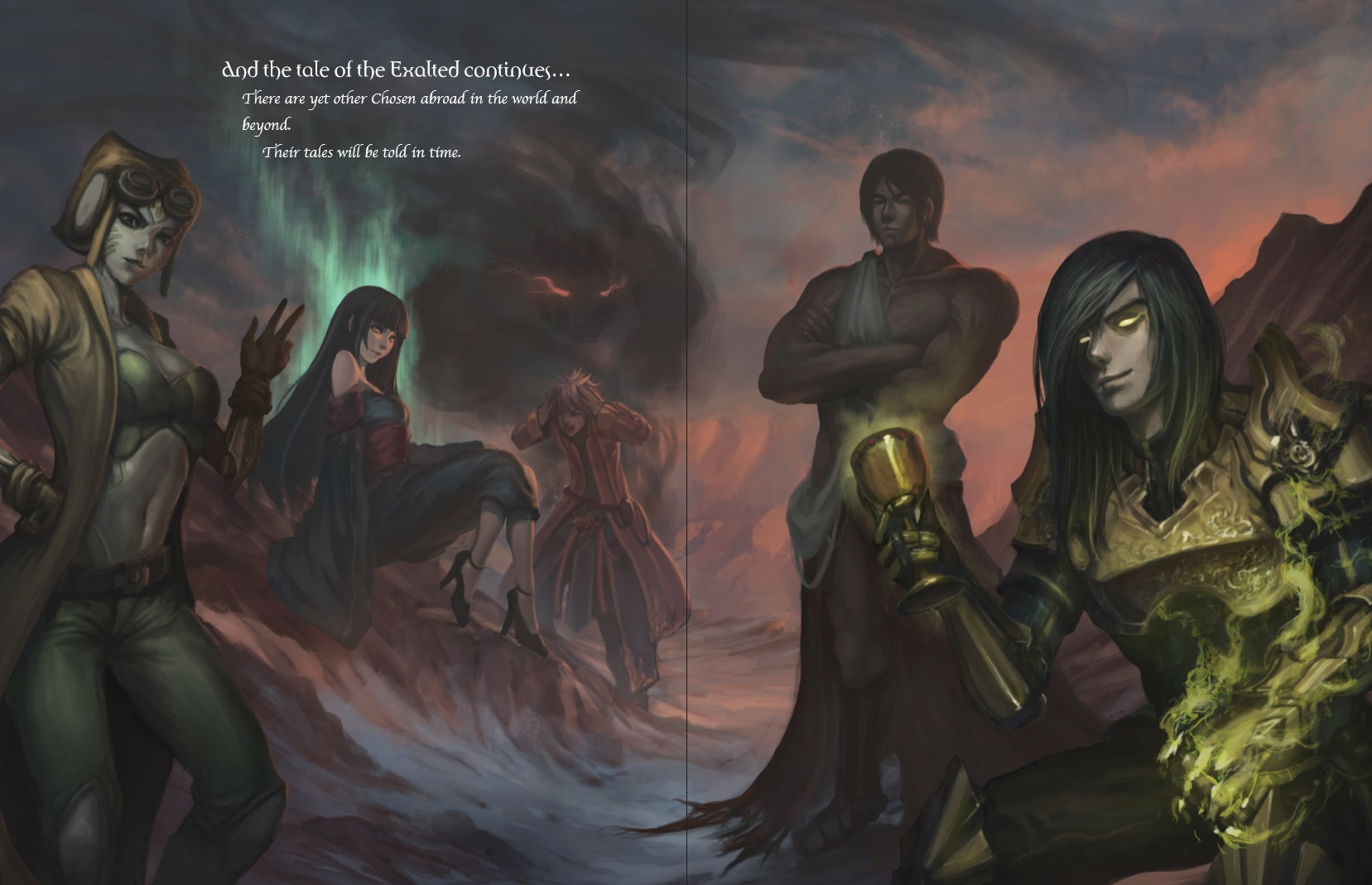
Buy all our books! All of them!
A two page spread telling you there’s gonna be MORE AND DIFFERENT types of exalted that they couldn’t cram synopses of into this book ends the chapter. From what I know, Infernals are already confirmed, so we can look forward to that at some point, I’m sure.

Next time! Chapter 2: Setting (Or: We’re almost to the good stuff, guys, I promise.)
Setting
Original SA post
To Protect Flavor posted:
Bought into 3e Exalted in part because of the ongoing review here. Gotta say, despite the reputation, it seems like a fun time.
Then again, my group's been slogging through a Hero System campaign of late, so maybe I'm just desperate.
I honestly do think that despite Exalted’s checkered past and present, 3e is largely a step in the right direction. As Alien Rope Burn said, you can clearly feel how much they care about it by reading it, and I largely think the systems work out well for the most part. I’m not gonna begrudge people for not liking it based on the shit that’s come before, but I also think it’s important to support “yes, this is the direction I want from this”. That said, it’s nice to hear someone bought the game off my review. Thanks friend.

Anyway, enough of that, let’s try and get through some more fluff so that the next update can start on actual mechanics!
Part The Second: Setting
We’re at least getting into the parts of the book that can be way more easily summarized. Which is good, cause there’s like, 60 whole pages worth of setting to read about! Yeesh. Luckily it’s a fun enough read and not -all- of it is important, depending on your character.
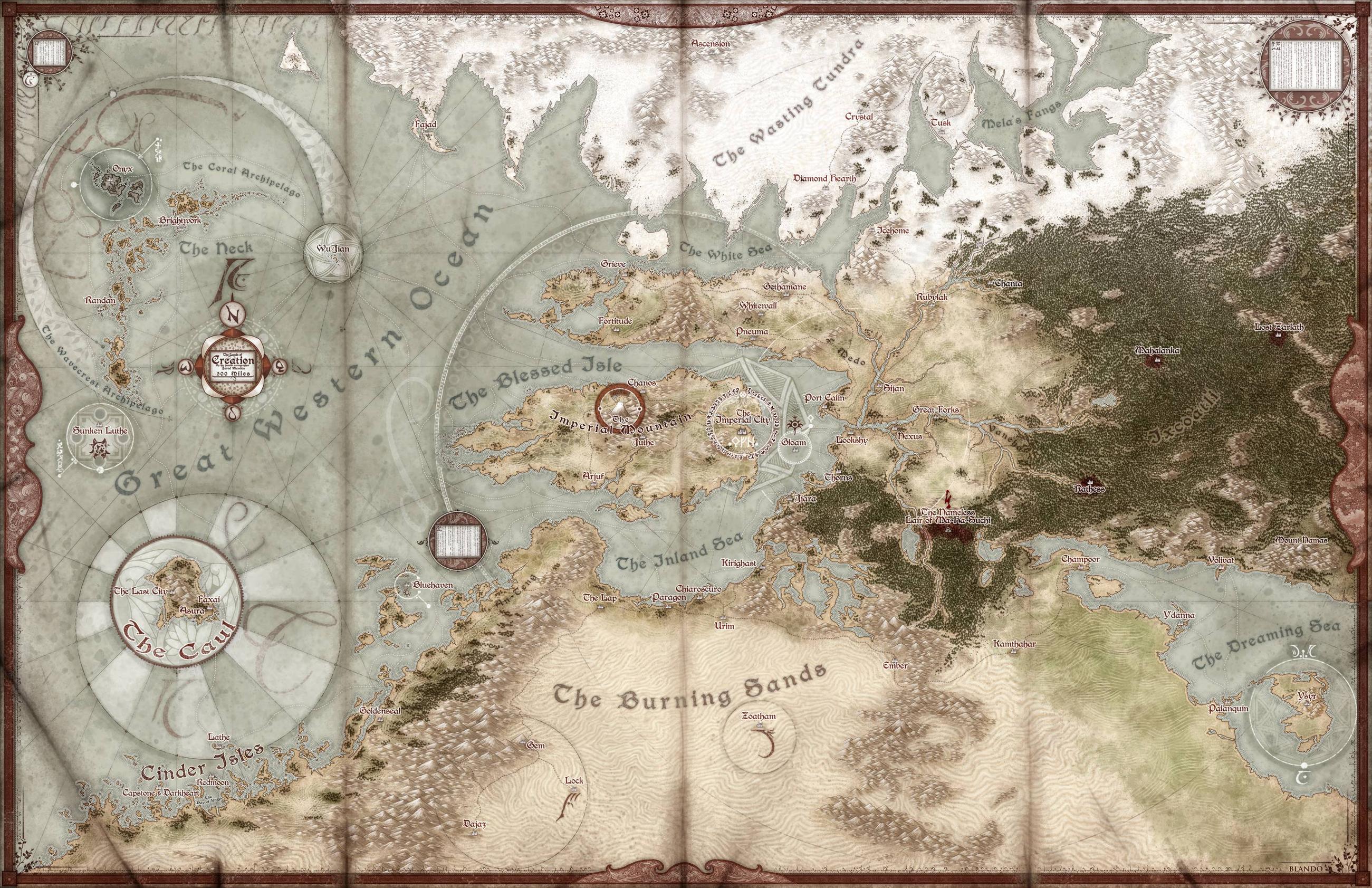
Also, they massively increased the real estate from 1/2e to 3e (you should probably open this one in a separate tab)
So! Setting. Exalted’s setting is best imagined, in the words of its own book, as a flat world floating atop a sea of chaos. That chunk of floating thing-that-exists is what’s known, broadly, as Creation. Outside of Creation is The Wyld, which is where Salvador Dali and M.C. Escher decide that this shit is way too weird for even them, but we’ll get into that later.
Creation, the flat plane that it is, is anchored in place by the five Elemental Poles.
- To The South: The Pole of Fire, surrounded by deserts, ruins beneath the sand, lost cities, and coastal trade towns. There’s not a lot to do here without plot, as desert dominates most of the southern landscape.
- To The East: The Pole of Wood gives you a massive overgrown jungle, massive forests, and plains for days. Ruins are -also- aplenty here, as are jungle temples and all your Indiana Jones fantasies.
- To The North: The Pole of Air. It’s basically fucking Northrend from Warcraft, or the upper half of Skyrim’s map. It’s bitterly cold, and while there are some cities that have civilization, the nomads out in the tundras are crazy and the rest of the environment wants you dead.
- To The West: The Pole of Water and, surprising no one, a giant fuckoff ocean! This is where Sail becomes the most useful, because no one has any fucking clue about thee West. The Realm tried to take it over but they got fucking WRECKED so they decided fuck it, not worth it.
- In The Middle: The Pole of Earth and the Blessed Isle, home of the Realm. This is where Creation is at its most stable but, SURPRISE, it’s full of douchebags and petty politics.
We’ll get into some hotspots later, but right now the book wants you to know the who’s who of divinity. See, Heaven is a real place, and there’s all sorts of spirits, elementals, demons, demon princes, miscellaneous divinities, and yes, gods. Most of them are stuck bickering in bitter politics and portfolio expansion while using mortals to advance their agenda - and these are the ones you’re likely to encounter. But there are gods, and there are Capital-G Gods. Those guys are the real untouchables of the setting, and here they are, in no particular order:
- The Unconquered Sun is the biggest of the big-namers. The protector of Creation and patron of the Solar Exalted. He was the one to first suggest Exalting Mortals to overthrow the Primordials - the Gods’ creators. In times long past the Solars indulged and fucked around enough that he turned away from them, but now he’s back and supporting the new Solars.
- Luna is the lover of the Emerald Mother and Primordial Gaia, and patron of the Lunar Exalted. She has a thousand forms, many of them contradictory, but she’s also the most active of the big name gods (or Incarnae, as the book uses).
- Gaia is the last Primordial standing after the Exalts and Gods kicked the rest out. She betrayed her ‘brothers’ due to their misconduct and urging from Luna. Her body is Creation itself, but it’s said that she has a form of a majestic woman robed in green - though it hasn’t been seen in nearly an age.
- The Five Elemental Dragons are neither gods nor demons, nor mere Elementals. Described as Gaia’s children, they are the patrons of the Dragon-Blooded Exalts, breathing the power of their elements into their blood.
- The Five Maidens are the most inscrutable of the lot. Fond of talking in riddles and rarely speaking otherwise, they are the Ladies of Fate and the patrons of the Sidereal Exalted. They are Mercury, Maiden of Journeys, Venus, Maiden of Serenity, Mars, Maiden of Battle, Jupiter, Maiden of Secrets, and Saturn, Maiden of Endings. It’s said they occasionally leave Heaven, but only when needed and if one of them vanishes all of Heaven just about shits itself in panic.
After that, we’re treated to a brief depiction of The Realm. It’s the biggest superpower, it’s the greatest empire in Creation (at current). It’s… kind of a shitty place to live! You follow the Immaculate Order or you’re out, and if you aren’t a Dragon-Blooded house you basically aren’t worth shit. It’s been vacuuming up pretty much all the wealth it can for a while now, and while things were all nice and smooth while the Scarlet Empress was here, she vanished five years ago.
We take a break from talking about the Realm to bring up… are you fucking kidding me, MORE Exalted?
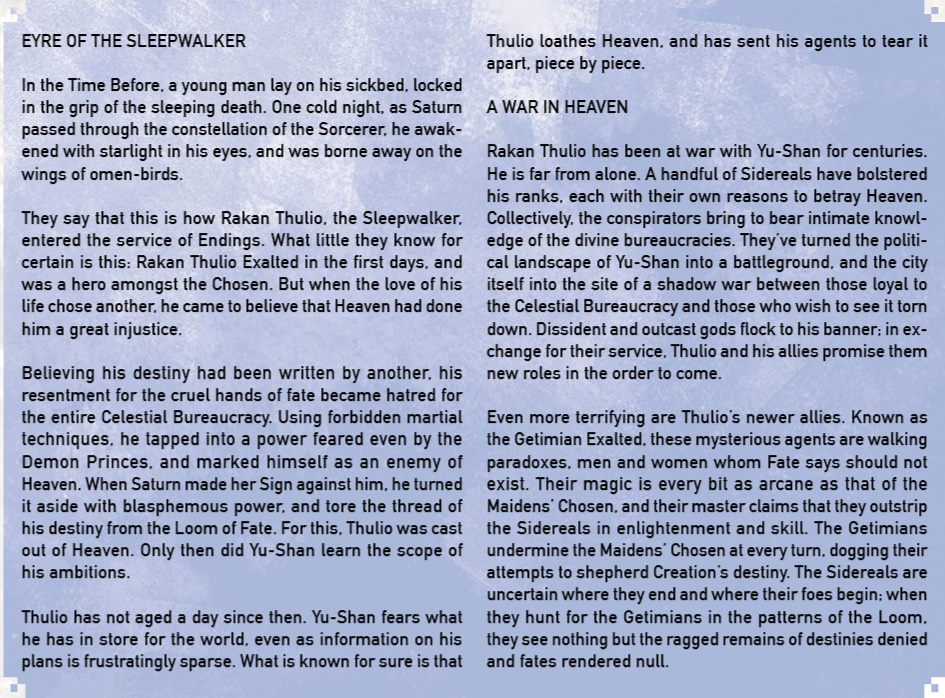
I guess the Sidereals needed their big spooky foils, too.
Okay, so, let me take a breather to summarize how many Exalted we have now. Solars, Lunars, Sidereals, Dragon-Blooded, Liminals, Abyssals, Infernals, Alchemicals,
SO, ANYWAY, The Realm puts a figurehead jackoff at the head of affairs while setting up The Deliberative, which is basically just the Great Houses bickering with each other and running roughshod over the whole operation. I’m not gonna summarize them because their blurbs are short enough already, so:
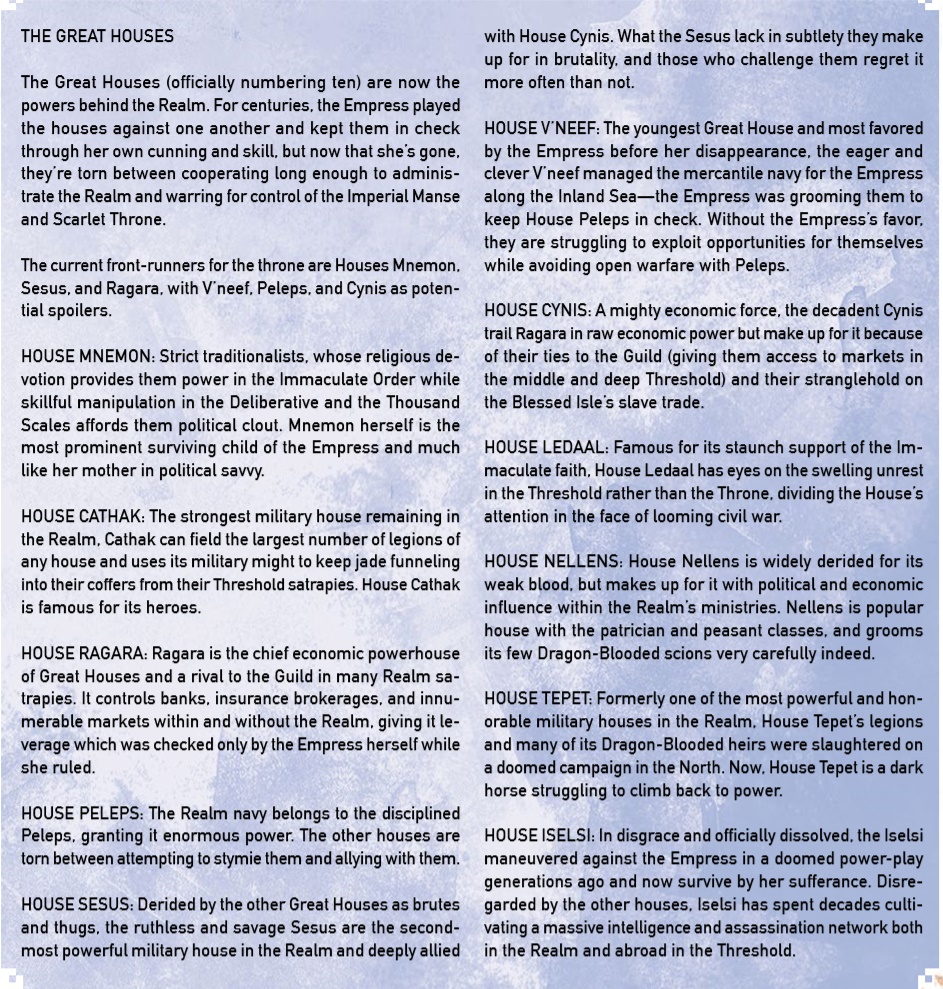
Also featured: House Iselsi in the ‘lol you idiots’ corner.
It goes on to jerk itself off a bit about the Immaculate Order, how Dragons are “suited to rule mortals by right of superior spiritual station”, how awful and classist the whole setup is (If you aren’t part of one of the Great Houses you’re treated as shit by them, but even the most worthless Dragon-Blooded is untouchable to a Mortal), and how the Five Elemental Dragons incarnated into specific individuals each espousing a tenant of Immaculate Faith.
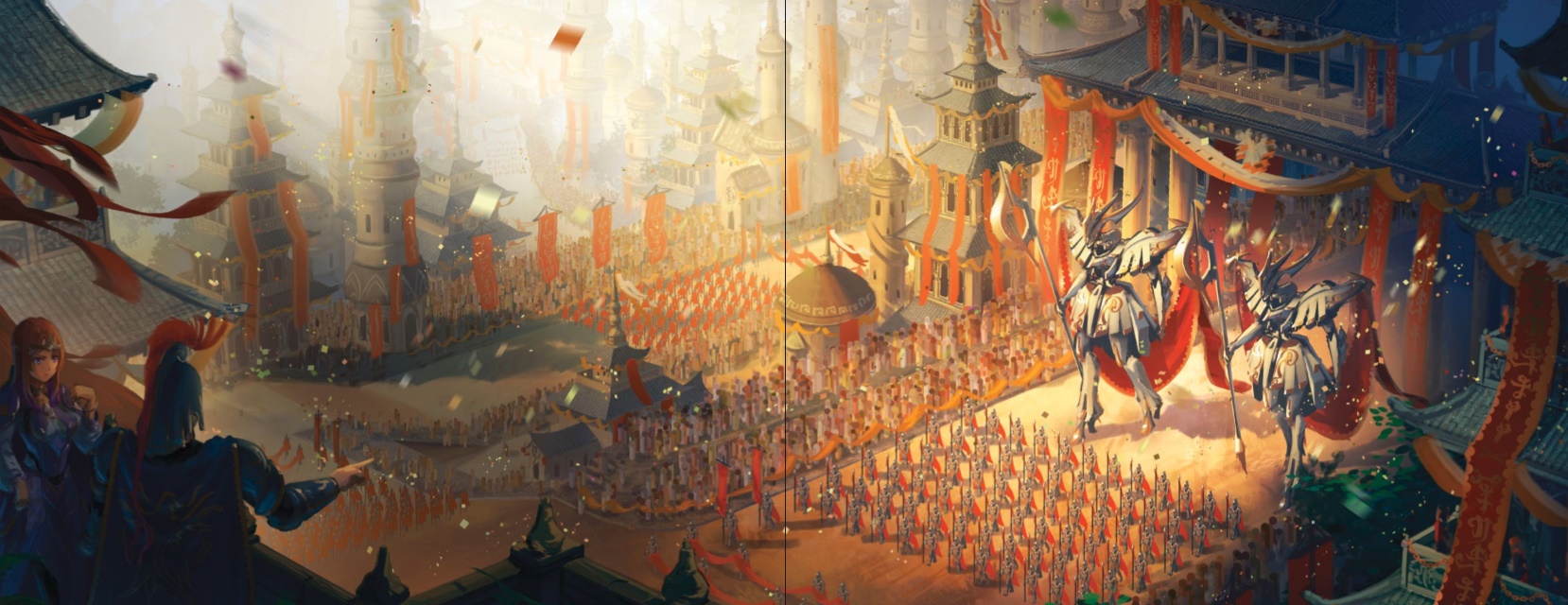
Nice warstriders, though.
They’re also apparently kind of dicks to the other, non-Solar/Lunar Exalts:
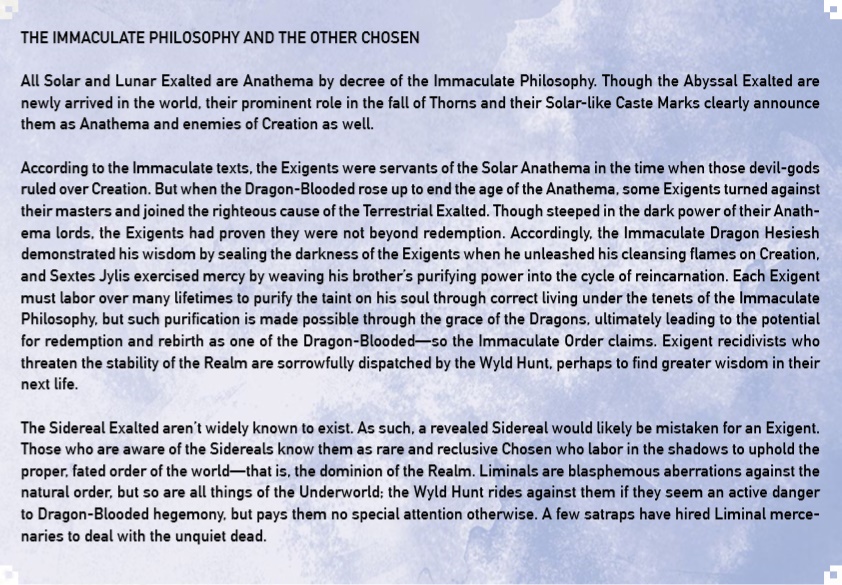
”You must work over many lifetimes to reach the greatness of a Dragon. It’s okay, it’s not your fault.

After that, we’re given a brief overview on “The Guild”, which is a for-profit group of mortal mercantiles and enterprisers who’s wealth is the only thing that comes close to the excess of the Dragon-Blooded houses. It’s noted while they help many, there’s also plenty of money that they can and will make in drug and slave trade. Charming, but at least it’s a pretty typical plot point that never runs out of steam.
There’s also a few pages devoted to economy and money in Creation but I’m not gonna go into that shit, like, at all. That’s better suited for working out in individual player groups.
Instead, we get to a description of places that -aren’t- the Realm, which is collectively referred to as the Threshold. There’s a massive amount of places of note, and to summarize them would make this update way longer than it already is and I want to start getting into the crunch here soon, so let’s just read off some of my favorites, shall we?
For the North:
- Fortitude: A massive cursed fortress-prison from the first age that is now home to gangs and other prisoners that survive on an SMT Chaos Hero-esque philosophy. Underneath the sprawling-out-of-control fortress is a primal god that convinced them darkness is to be worshiped and that the only way to cleanse ones sin is to lead a heroic life, then die.
- Ascension is a city built in the side of Creation’s equivalent of Mt. Everest, kept sustainable by ancient Solar artifacts, and is a last stop for those trying to head further up the mountain to the mysterious mines above.
For the East:
- The Scavenger Lands occupy the Near East and further beyond and are basically a sandbox for campaigns in and of themselves. It’s noted to be one of the major areas that isn’t immediately controlled by the Realm. A good chunk of setting is here, from the city-state of Nexus that is the home of the Guild, to Lookshy - a former centerpiece in the defense of the Scavenger Lands that awakened something beneath it, and now what few Dragon-Blooded remain in the city are under the control of something yet darker than petty politics.
For the South:
- Chiaroscuro is a shattered metropolis of the First Age, a Zanarkand that was ruined, found once more, and became one of the most famous ports in the world. It comes in third in the ‘wealthiest cities’ side. Behind the Realm and (barely) Nexus, but has a massive amount of ruins that not even the city has fully explored.
- Gem is an underground city, nestled in a dead volcano, full of all sorts of modern oddities. Holding a stranglehold on the gemstone market (naturally), it’s yet another trade hub but one that feels much more like an ‘black market’ hub than any of the others.
For the West:
- Wu-Jian is the city from the opening story I didn’t read! A lawless hive of scum and villainy in all the best and worst ways, it’s a port hub that sees overcrowded slums, alleyways that are closed by centuries of construction, and houses stacked so high it’d make the Walled Kowloon City balk.
- Onyx is a city straight out of a metal album cover - the dead walk alongside the living, where even the poorest shopkeeps have at least a skeleton to command, and the whole island considers death not an end, but a gateway to new life. Death is seen as a promotion, most unsettling is probably the fact that the Deathlord known as Bodhisattva Anointed By Dark Water is the ruler of the city, attending mortal and deathly courts alike, and attending performances of ‘necrodramas’.
There’s more than a few other places, such as Dominions of Lunars living on the fringe-edges of creation, ruins of lost cities, and of course, The Wyld and the Fair Folk that reside within. Fair Folk themselves are terrifying, entities of chaos that consume the hopes, dreams, and souls of mortals in order to sustain themselves, and while interact with Creation in some respects, would love nothing more than to see it fall.
And then of course, the underworld is a real place, and you can go there, but it isn’t advised. It’s here we get talk of Shadowlands (areas where life and death intersect, the Veil is thin, etc etc) and talk of the Deathlords in detail - sorcerer-kings shrouded in mystery, and of whom no two are the same. The book says that it’s rumored there are “at least five, but no more than a score of them”, and It’s here we get introduced to a few big bads that may work against you, or each other.
The Mask of Winters is the one most campaigns will be concerned with, as the Scavenger Lands are a zone easy to build a campaign around, and Mask of Winters made his debut 5 years ago, ransacking the Realm’s greatest hold in that area - the city of Thorns, riding atop the corpse-fortress Juggernaut, an undead behemoth with a city atop it. The other Deathlords hate him for his boldness and that his actions have brought about the knowledge of Deathlords as more than a rumor.
The Lover Clad in the Raiment of Tears is the go-to for a Northern campaign, a being of undead beauty and frustrated passions. She binds those with unfulfilled desires who die in the north to her whim, and these ‘Loveless’ wander the north in search of comfort and seeking out paramours to drain their passions -and life- dry as vampires of drive and desire. She has a pretty face, but she uses it to bring the desperate and lost to her and strengthen her power.
The Bodhisattva Anointed by Dark Water is the unending monarch of Onyx and the Skullstone Archipelago in the west, covered by shadowlands. He’s the source of Onyx’s beliefs that life merely is meant to prepare you for the “exaltation” of death. Dark Water isn’t as bold as Winters or as seemingly charming as Raiment of Tears, but he is cunning and willing to deal with the world of the living, his coin is the law in the West, and he’s the most willing to play the long game, trapping others in webs of favors, unpaid debts, and oaths and moving to annex territory once one of those is inevitably tread upon.
Oh, and then we get Behemoths proper. I’ll let the book field that one:
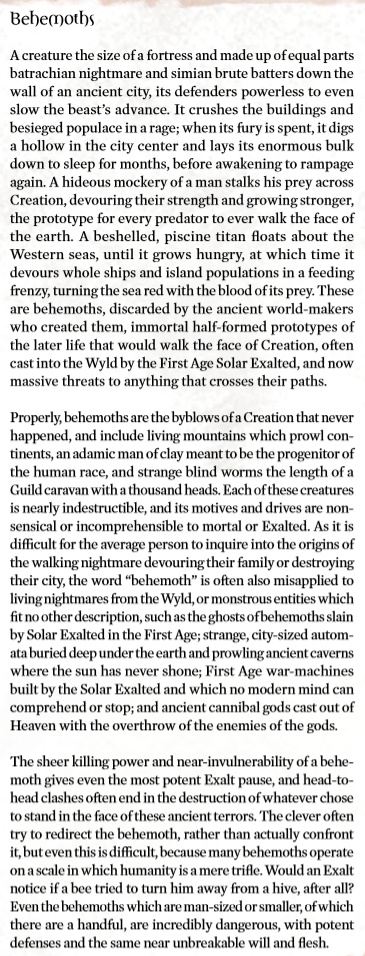
And that’s all she wrote for setting! I skimmed a lot of this, because there’s a lot of it -to- skim, but I honestly enjoy the amount of thought and detail that goes into the setting. It feels larger than life in the book, which helps, even if now we’re up to like ten friggin types of Exalted.
NEXT TIME: PART THE THIRD: CHARACTER CREATION.
Character Generatiion (And Stuff I Missed)
Original SA post good Storyteller System game.I know this is a bit late so let's get right into it.

Part The Third: Character Generatiion (And Stuff I Missed)
First thing’s first! Alien Rope Burn pointed out I skipped the Southeast, which is in fact, upon further review, a damn shame cause it’s some of the newest stuff and it’s absofuckinglutely bonkers.Whereas in the old versions the Southeast was, from what I can tell, basically nothing, here we get some detail about what a cross-section of the two different poles looks like: it combines the South’s mineral riches with the East’s fertile land - and at the heart of it all, the Dreaming Sea, an ocean pouring in from beyond creation and some pretty damn strictly Wyld/Fair Folk territory. Everything you could want is here - crops, spices, gems, precious metals, you name it.
So of course it’s only natural that any and all city-states around here aree getting swallowed up by upstart empires looking to stranglehold this chunk of Creation. There’s empires, intrigue, Fair Folk running amok, rogue gods, cults, and monstrous, weird beasts warped by the Wyld and the Dreaming Sea.
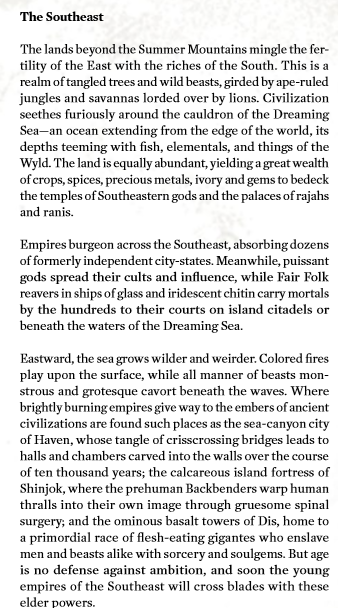
Seriously, it kind of fucking owns. Sounds like a good campaign setting if the Scavenger Lands weren’t like, right next door.
So what are the hotspots? Well, we’ve got Kamthahar, capital of the empire of Prasad. It’s got caste and clans with their own walled compounds in the city. Reminds me a lot of Ragnarok Online PvP, actually. Dragon-Blooded rule the city, but here the Immaculate Philosophy is warped into thinking that the Dragon-Bloods are actually gods. UNSURPRISINGLY Immaculate Monks don’t like this and sometimes show up to throw down with Monks of the ‘Pure Way’, as they call it.
There’s also Champoor, a city cloaked in eternal night on the coast of the Dreaming Sea. It’s that way because there’s an actual goddamn water dragon ruling the city. She also runs one of the few courts of like-minded gods left - the corrupt Court of Secrets. The city’s criminal classes forming priesthoods to dark gods and undersea elementals, and pretty much everyone and their mother has some sort of divine magic to do their day to day workings. Combatting rivals, transporting goods, or just good old-fashioned brawling. In exchange, they make sacrifices to these gods, in the hopes they won’t be the one caught without godly back-up.
Ysyr is a city built on First Age ruins, full of people warped by unregulated sorcerous engines that kept the old city of Pinnacle running. These people are now attuned to the power of sorcery, but only a few of them can actively tap into and master this gift - easily identified by their physical perfection thanks to sorcery, while those that can bear lesser mutations, marks of servitude and slavery, for you’re either a sorcerer or a slave.
On the isles just on the coast of the Dreaming Sea is Palanquin, which might be my favorite of the cities. Propped up by the
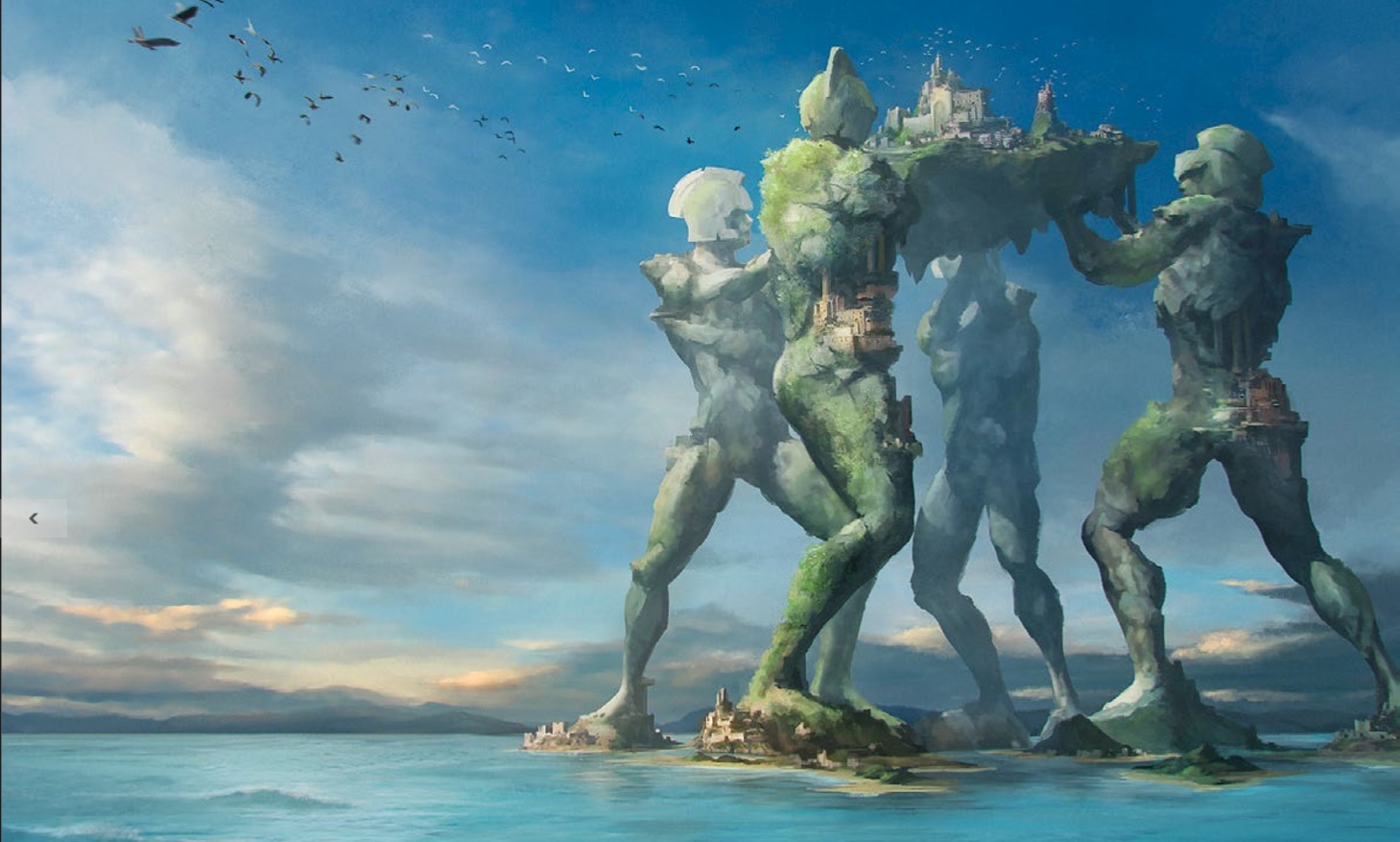
Have I mentioned how fucking killer the art is recently? Cause like, holy shit.
At the top you have a temple city - full of religious types that see themselves closer to Heaven than the other land-locked cities - an attitude supported by the City of Blue Gauze, a city that trades with Palanquin and is full of cloud-folk. The city itself has nobles who have cloudfolk blood and thus a “otherworldly beauty and capricious nature.” Though it’s stated Palanquin isn’t as powerful as it once was, given the sorcerer-kings of Ysyr conquered it about a hundred years ago. At the center of the city though is a defunct gateway that’s said to lead to Heaven, but instead leads to something far more sinister - Zen-Mu, the fallen celestial capital of the ancients. Probably not a good idea to go there now, though it’d make one hell of an adventure.
Last on our quick romp around the Southeast and get to Character Creation is Volivat, a city carved out of the sea in the first age, resting a hundred fathoms below sea level, kept dry by a pump and dam system that functions to this day. Rising out of the sea are towering spires where alchemists create artificially fertile miniature gardens of Eden.
Volivat was flooded over during the Great Contagion in an attempt to quarantine the city, nomads found the city, reactivated the pumps, and found many relics and texts of the former Exalted, deciding to shape themselves in the image of the city’s founders. They call themselves ‘Yennin’, Children of Ten Fathers, and an ancient formula found allowed for the creation of offspring with up to ten fathers, each contributing to the birth of a single child. This basically allows them to pick and choose the best qualities in a Gattaca-esque Ubermensch, only the best of the best contribute to the next generation, which has hilariously fucked over clan/family bonds and any sense of separate family lines, mentioned as being “largely incomprehensible to outsiders.” Because of this, though, Volvidat have some of the strongest mortals in creation. “Enhanced by the combined strength, wit, and Essence of eleven parents, the greatest Yennen champions are a match for the sorcerer-princes of Ysyr and the Dragon-Blooded warriors of Prasad.”
So, that’s the Southeast! It doesn’t such - quite - as much as Scavenger Lands, but where it sucks, it really sucks. Now, onto some actual crunch.
Character Creation
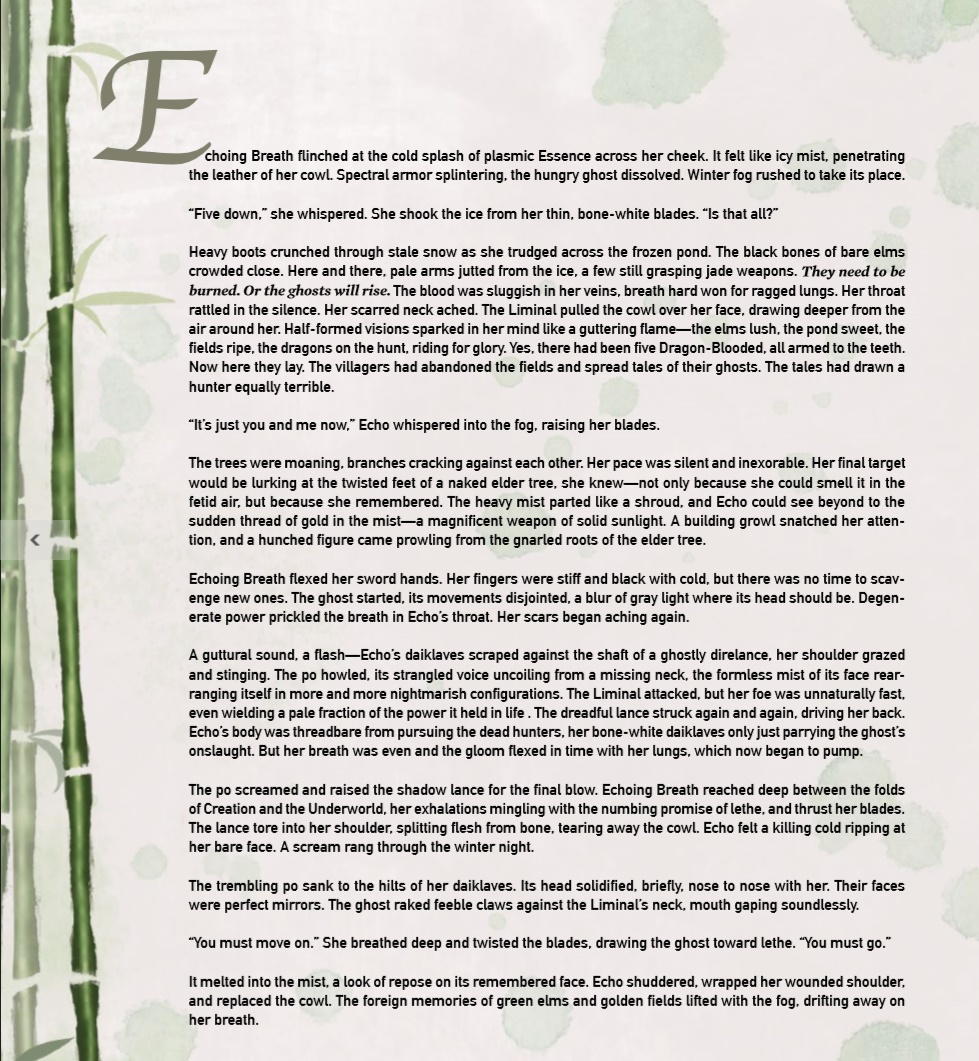
Like all the chapters, this one is a prelude to a story. Unlike the others, though, this is a short one-page story involving a Liminal - I mentioned how they’re sort of like Exalted Prometheans, but this is one of the stories I actually really like, and it actually sells me on the idea of playing one of these composites. It tells of Echoing Breath, a liminal hunting down the ghosts of Dragon-Blooded that hunt the land - coming face to face with the one who fave her her own patchwork face.
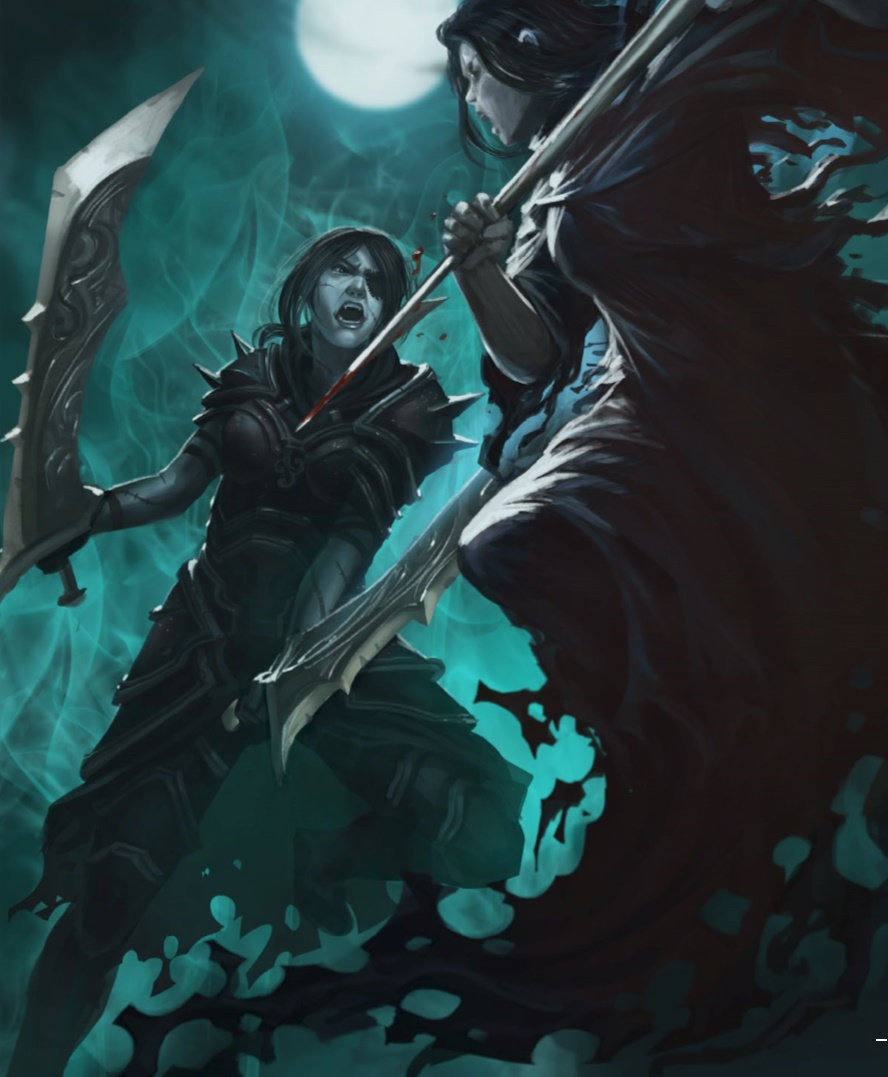
It helps, again, that the art is kind of bad-ass.
So! Characters! Exalted gives us a brief primer on the basics of putting together a character for its system. To put down in words what you want your character concept to be, the pump your DM/ST for information that’ll make it easier to put together a concept for a specific character in that chunk of Creation, and, most importantly, to think larger than life. It then goes into a quick overview of the Storyteller system - though not a whole lot, it simply gives us an overview of how abilities and attributes are rated (1-5 dots), with one dot being poor, two being average, three being average, four being exceptional, and five being masterful. While the setup is closer to oWoD’s arrangement of attributes than nWoD’s - for example, Composure isn’t here, and the whole idea of Force/Finesse/Resistance isn’t applied, it plays like relatively modern Storyteller - as explained previously, your dicepool is the combined number of Ability + Attribute d10s, with modifiers from miscellaneous things like Charms and the like. Unlike standard Storyteller. You then roll those dice, and any dice that comes up 7-10 is a Success, with 10s counting double. The way the math works out on that is that, on average, you’ll want about double the dice for the number of successes you want to roll, barring other factors.
The first step they give you is to figure out your Concept and Caste. Figuring out a simple beat to sketch your character from. I’ll use my own character from my currently-running Exalted campaign as an idea. Grasping the Sky With Hands Outstretched (‘Grasping Sky’ or ‘Sky’ for short) is a man who called the far-western city of Onyx his home. Rising through the rankings of Onyx’s own military - to near the highest one could get without taking the long nap. Having found out the truth of Onyx’s death-based culture (and a Soulsteel forge using ‘missing’ souls from the city as power), Sky decided he didn’t want anything to do with Onyx - and became an Exalt as he was forced to fight the undead legionaires of Onyx on his way out. Now, he wanders the lands as a travelling warrior, hoping to right wrongs and ease his own peace of mind. The original concept being a Ryu-esque Wandering Warrior who had a reason he didn’t want to go home.
Now that the concept is done, we figure out the Caste. Sky’s was easy - I wanted him to be a peerless fighter, so I made him a Dawn caste, but a quick overview once more of the Solars, since it’s been a hot minute since we went into them.
- Dawn: your Fighter. Warriors and champions without peers.
- Zenith: your Paladin. Equal parts fighter and holy man, commander of armies, leaders of men.
- Twilight: your Wizard. Loremasters, occultists, and sorcerers with access to world-shaping magic.
- Night: your Rogue. Assassins and thieves, they are as deadly as they are stealthy - and there are none stealthier.
- Eclipse: your Bard. Travellers, diplomats, and socialites without equal, who can cast magic in a pinch.
Once you’ve chosen your concept and Caste, it’s time to figure out what your Attributes are. Much like in standard Storyteller fare, You’ve given three categories, and asked to allocate each one to Primary, Secondary, and Tertiary, split among Physical (Strength, Dexterity, and Stamina), Mental (Perception, Intelligence, Wits), and Social (Charisma, Manipulation, Appearance). In Blue Book nWoD/CofD, you’re given 5 points for your Primary, 4 points for your Secondary, and 3 points for your Tertiary. That’s chump change, this is Exalted, motherfucker. Exalted gives you eight points for Primary, six points for secondary, and four points for Tertiary. You’re a demigod among men, and you’re gonna damn well have the stats for it. As always, the first point is free. Like CofD, the fifth point doesn’t cost you double - and Exalted encourages you to take a five if it fits with your style.
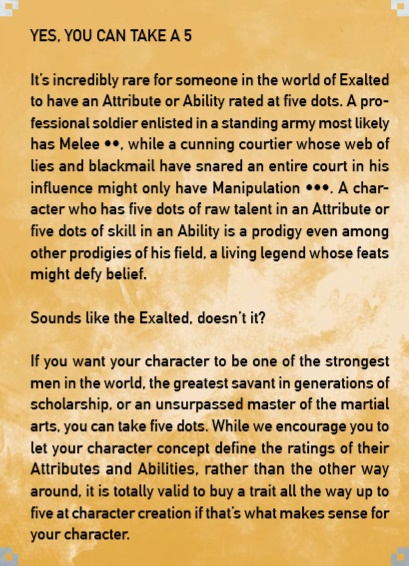
Of course, I had to go into the next chapter to find this, but points for the attempt, OPP.
Then we get to Abilities, which is really where the differences between 2nd Ed and 3rd Ed start to shine. Abilities are your ‘skills’. They’re divided up in general areas of knowledge, with 25 (Or 26. depending how you count Martial Arts, but we’ll get to that much later) skills in all: Archery, Athletics, Awareness, Brawl/Martial Arts, Bureaucracy, Craft, Dodge, Integrity, Investigation, Larceny, Linguistics, Lore, Medicine, Melee, Occult, Performance, Presence, Resistance, Ride, Sail, Socialize, Stealth, Survival, Thrown, War. From these 25, you pick ten. Five of which come from your Caste, and five of which come from personal preference, called Favored. Caste and Favored abilities are important for a couple reasons. The first is the ability to Excellency these rolls, adding dice to them by spending points from your Mote Pool (again, something we’ll cover later). You can never more than double these rolls, but it works in pretty much all circumstances you would want it to. The second is that Favored/Caste abilities have lesser experience requirements than their peers - it’s generally easier levelling up one of your chosen abilities to 5 dots than the others, and charms for your Favored/Caste abilities cost significantly less, when you add it up. The book provides us with a handy summary of who gets what Caste abilities.
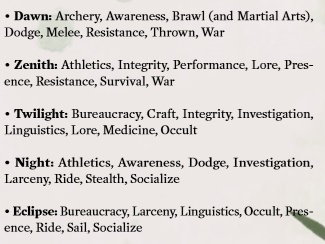
Now, here’s why I like this. In 2e, each Caste got 5 abilities with no overlap. This 1: Made things a bit cookie cutter with character generation, 2: Made it harder for one caste to fill another’s role, and 3: Had the side effect of making Eclipse feel really useless since they got a lot of the more “situationally useful” skills, like Ride and Sail . WIth this setup, there’s enough overlap that while each Caste is still distinct, they can nominally fill each other’s roles - an Eclipse has access to Sorcery, a Zenith can pick up Socialize and be the diplomacy specialist or specialize further in combat trees and be the bruiser instead of having someone play a Dawn. About the only thing that has very little overlap is the Night Caste’s schtick of being extremely stealthy, but even that, to some degree, can be covered by an Eclipse with a focus on Larceny. Thirdly, it just allows more diversity - picking five out of seven charms for each of the Castes, with five others favored, gives everyone in the party a wider range in terms of character expression and utility - although, it is recommended for the classes that aren’t Dawns pick up some form of combat ability or charm.
Once you’ve picked your ten abilities, you pick one of your five Caste abilities to be your Supernal Ability. This is your most powerful ability, it’s the one in which your Essence (which is a rough gauge of your power level, from “newly Exalted” to “the ultimate demigod”.is ignored for meeting prerequisites to obtain charms. I’ll be honest, this is most useful at chargen, getting a headstart on the bigger charm trees, but maybe I wasn’t using it correctly, maybe there’s just too many charms I’ve been dealing with, but Supernal has not really helped me stay appropriately ahead of the curve in terms of abilities. It -does- let you get some sick shit early, which we’ll cover when we start covering Charms.
Once you have your Caste, Favored, and Supernal Abilities locked in, you split 28 points between them. Unlike Attributes, Abilities start at 0, and no Abilities can be raised above 3-dot without spending some of your end-of-chargen bonus points, and Favored abilities must have at least one dot. You can put dots in abilities that aren’t your caste/favored, and the book actually recommends you do this now, since it’s easier than buying them later. After that, you assign four ‘specialties’. Which give you a bonus dice on checks when the circumstance is met. Specialties can be or broad or as narrow as you want, though the Storyteller is specifically said to have the final say, and there has to be cases where they can’t apply that would come up in play. Some skills, notably Craft and Lore, come with a specialty baked in - with the caveat that you have to use that specialty for those skills. All others, you can use without invoking your specialty if you need to.
After that, we get into Merits. Merits are yet another beast I’ll cover later, but they’re simple enough to summarize - these are often your ‘intangibles’. Special skills, little quirks, things that set your character apart from the rest. Rest assured they’re similar to standard Storyteller fair - you have ten points to buy up Merits, that you can purchase at various dot ‘levels’. Naturally, there are some that you wouldn’t expect in CofD - Cult, Artifact, etc. But there’s still say, Mentor, Contacts, Resources, and most all the ones you’ve come to know and expect.
Next, you get your Charms. The Charm list is several miles long and I intend to cover in excruciating detail when we get to that chunk of the book. Though I guess it’s worth mentioning right now that I think Charms in 3rd Edition are much, much better than their 2nd Ed counterparts. I know there was some complaints of not being able to untangle the flavor text from the effect of the attack, but I don’t think there’s much of an issue with 3rd Edition Charms as there have been in the past. For now, just know that Charms are how you do all the most ridiculous of Exalted stunts, and you’ll start out with fifteen. This is where Supernals come in handy, because there might be a charm you -really- like that’s Essence 2 (All the Exalted start at Essence 1) that you want. Said Charm can be picked up at chargen if it’s in your Supernal Ability. It’s important to note here that if you’re a user of an Artifact, a Martial Artist or a Sorcerer, you can exchange one of your fifteen starting charms for a Martial Arts Charm, Spell, or Evocation (Charms, but for Artifacts) on a one-for-one basis. It’s pretty nice.
Intimacies and Limit Trigger come next. Intimacies are the backbone of Exalted 3e’s Social System, and they’re the things you care about, for good or for bad. They can be a material thing; a place, person, an object (called a Tie) or it can be a concept, idea, or philosophy (called a Principle). All Solars must have -some- intimacies when they start the game. At least one Defining (a core part of your character concept), one Major (not as important as Defining, but still important to note), one negative (a thing your character hates) and one positive (a thing your character likes).
Limit Triggers are the way this book manifests the Great Curse of the Exalted. The Limit Trigger is a scenario in which your character accrues Limit, which may end up making things harder later - it’s, essentially, a situation your character never wants to find himself in. Naturally, a good Limit Trigger is one that has some flexibility - enough for it to come up once in a while, but no so common that it comes up all the time.
And then, to wrap it all up, we get Bonus Points - 15 for your character to spend on rounding your character out, with a handy block of bonus point costs:
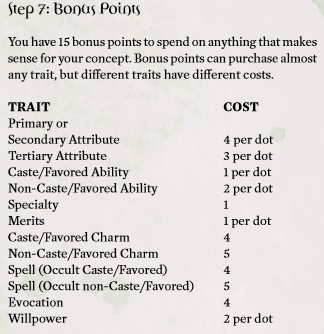
They explicitly make it easier to shore up your Tertiary so that your character isn’t -completely- lacking in an area you were forced to commit as a Tertiary attribute, but otherwise the rest of the fare is standard.
After that, it talks about the static values you’ll be putting together for your character. You get seven Health Levels, five Willpower, and a default Essence of 1, a Pool of 13 Personal/33 Peripheral Motes. After that, it goes into some roleplaying tips - thinking about who the character was before they Exalted, and that Exaltation is very much a life-changing event, and of course, to collaborate with your players so that you all aren’t bringing the same thing to the table.
And that’s it for character creation! I was gonna show off a sample character created in the book (Isthus Fithi, a Night Class former assassin on the run), but I’ve been wrestling with the interactive character sheet stalling out my PDF reader for about 90 minutes now and it’s honestly not worth it to fight through, so here’s that chunk since it’s not that long to read:
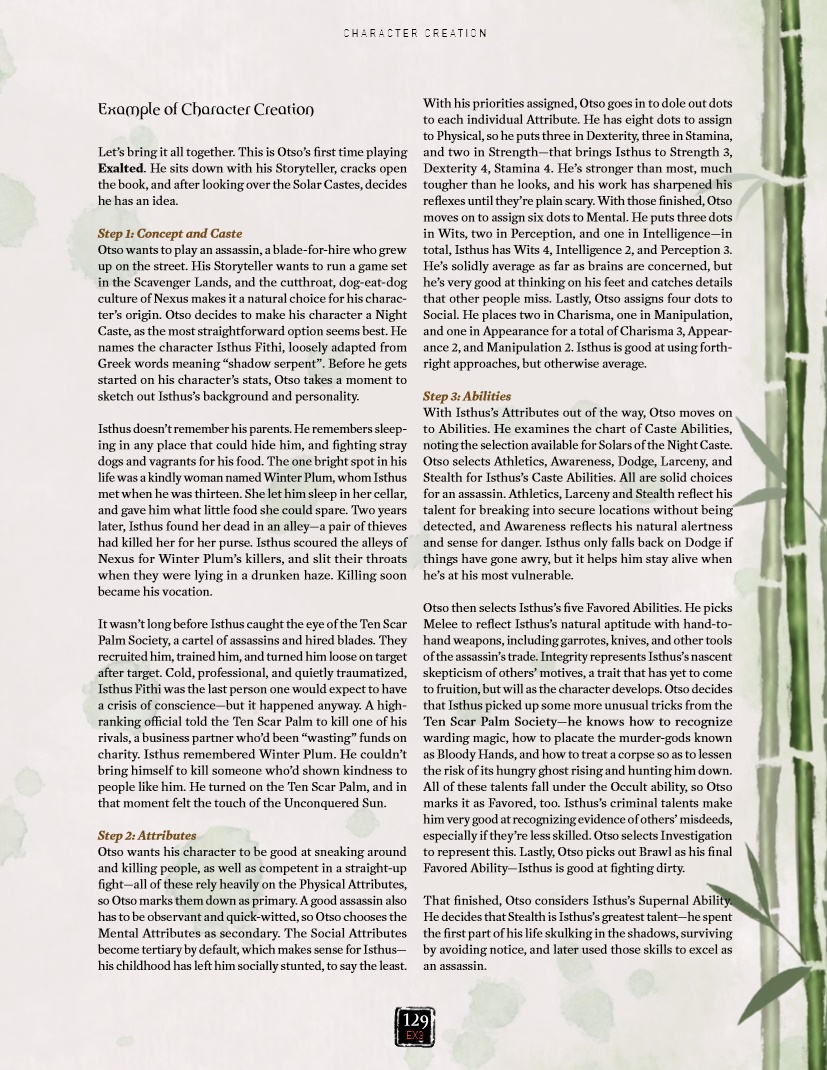
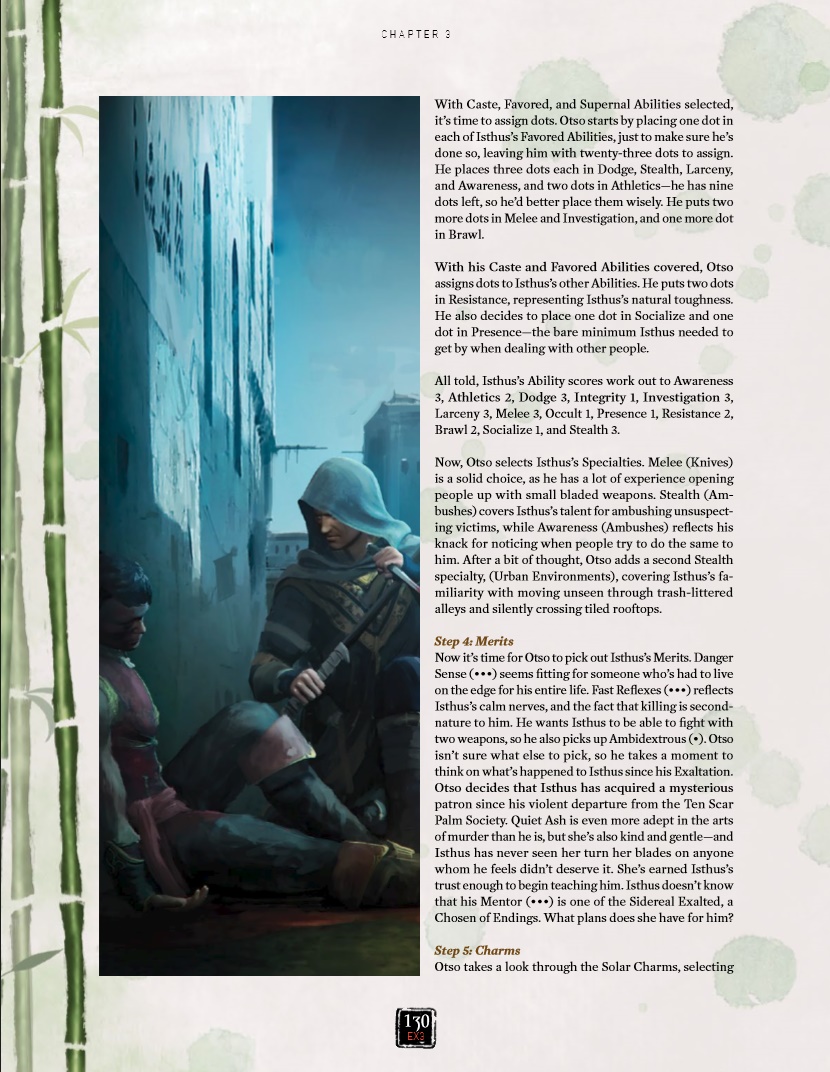
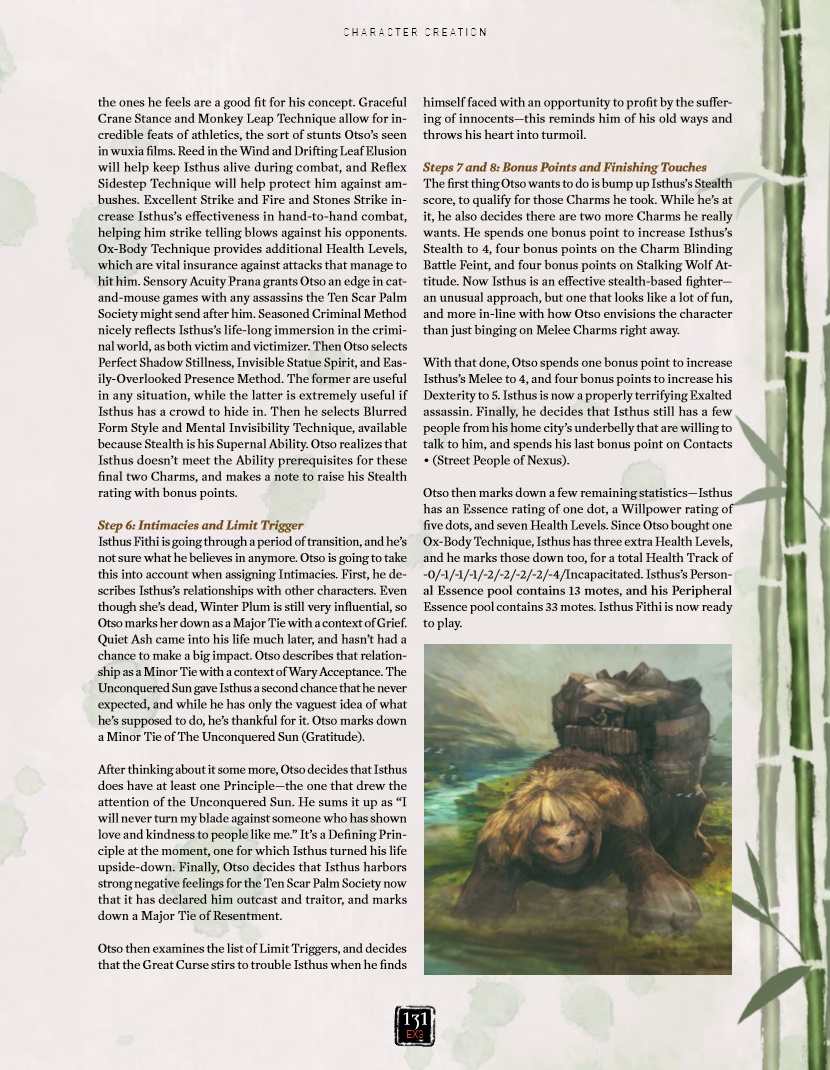
Next: Chapter 4: Traits, or “Maybe we should have put this somewhere else in the book instead of one hundred thirty pages in.”